View catalog Search
Search Zoeken
Search results


An All-Inclusive Guide On How To Use 12 Different Corkscrews
December 13 2020

- How to Use a Wing Corkscrew
- How to Use a Waiter’s Corkscrew
- How to Use a Two-Step Corkscrew
- How to Use a Laguiole Corkscrew
- How to Use a Corkscrew Without a Lever
- How to Use an Oneida Corkscrew
- How to Use a Wall Mount Corkscrew
- How to Use a Wine Cork Extractor
- How to Use a Tabletop Corkscrew Puller
- How to Use an Air Pump Corkscrew
- How to Use a Continuous Pull Corkscrew
- How to Use an Electric Corkscrew
All corkscrews have a single objective: to help you remove the cork from the bottle so you can enjoy your favorite alcohol at your home bar . But why, with a task so simple and straightforward, are there so many different types of corkscrews? Well, each type has advantages and while the result is the same, the steps on how to use a corkscrew differs.

The basic principle is that you need the worm or the pointy screw-like part of the corkscrew to go into the cork so you can pull it out. But alas, science and technology have provided us with more options on how to open a wine bottle or any other corked bottle for that matter. We now have a wide array of options from old-fashioned corkscrews to electric wine bottle openers . This post features 12 of the best corkscrews available to help you make an informed choice.
1. How to Use a Wing Corkscrew
A wing corkscrew has a top handler where the center part of the corkscrew is the driller, enveloped inside two flaps and two levers. These twin arms provide extra leverage to remove wine corks with ease. These winged corkscrews are also referred to as “corkscrews with arms”.

- Simply position the opener over the bottle. Twist the handle to insert the auger into the cork and raise the opener's wings.
- Using both hands, push the wings down.
- To remove the cork from the spiral, squeeze the sides against the cork and turn the handle counter-clockwise.
Watch the video below to see the procedure in action.
2. How to Use a Waiter’s Corkscrew
A waiter's corkscrew has the main staff that has a driller, a retractable knife, and a lever to place on the bottle's lip for a smoother pull.

- Put the bottle on a table or flat surface and remove the foil.
- Carefully extend the double-hinged part and extend the worm so that it forms a T-shape with the handle.
- Holding the bottle with your non-dominant hand, use your dominant hand to center the tip of the worm in the middle of the cork.
- Twist the worm clockwise into the cork until the last loop is just above the top of the cork, trying to keep the worm straight as you do so.
- Hook the first notch of the hinge point closest to the handle on the neck of the bottle. Then pull up on the handle with your dominant hand until the cork can’t rise any higher. Then hook the hinge point at the end of the lever on the neck of the bottle and repeat the motion. The cork should slide out cleanly.
- To remove the cork from the corkscrew, hold the cork with your non-dominant hand and twist until the worm screw is out of the cork.
For more tricks on opening a bottle with a waiter’s corkscrew, watch the video below:
3. How to Use a Two-Step Corkscrew
A two-step corkscrew also called a “twist and pull” corkscrew, is actually identical to the waiter's corkscrew. It has the same main staff with a retractable knife, a driller, and a lever. It is a favorite in the beverage industry due to its ease of use coupled with its small stature easily tucked in a waiter’s pocket. This corkscrew contains all tools that are necessary to properly open a bottle and provide an elegant look while doing so.

- Using the retractable knife, open the lid of the bottle. Do this by dragging the tip of the knife in a circular motion around the neck of the bottle.
- Remove the foil.
- Next, place the tip of the screw onto the cork slightly askew so that when you twist the screw, it goes into the middle of the cork and not sideward.
- Continue twisting the screw into the cork with even pressure.
- Place the first hinge of the screw on the lip of the bottle, leave it in place with your hand, and pull the cork up until halfway.
- Finally, move the second hinge on the lip of the bottle until the cork is out.
Some people ignore removing the cork from the corkscrew and leave it broken or crumbled. However, it is important to remove the cork from the corkscrew once it is out of the bottle and keep it intact. So should you not be able to finish the bottle, you can re-cork it to maintain its freshness and taste.
To remove the cork from the corkscrew, unscrew it from the tool being careful not to break it. Also, make sure not to poke yourself with the sharp point of the corkscrew. Examine the cork for possible brittleness or damage so you may know whether or not you can use it again.
Below is a 1-minute video on how to use a two-step corkscrew:
4. How to Use a Laguiole Corkscrew
The Laguiole corkscrew has a simple yet efficient structure. It is made up of one main staff from where the retractable knife and the driller can be pulled out. This corkscrew has no lever but still does the job.

- First, open the cap with the knife part of the screw.
- After opening the bottle, place the screw in a horizontal position and then dig the screw down.
- Clip the cork's left side to lever the cork and pull it up using the right side.
Below is a visual guide on the procedure:
5. How to Use a Corkscrew Without a Lever
A corkscrew without a lever is also called a pocket corkscrew or a travel corkscrew. It is a subset of the screwpull corkscrew category and is one of the most affordable options you’ll find. Instead of a wide handle to grip onto, it has a simple circle that’s big enough for you to slip your finger into to pull up. This type of corkscrew includes a cover, so you can slip it into your purse or pocket and take it with you wherever you go.
The corkscrew without a lever mainly uses a driller and a cylindrical container. The cylindrical container of the driller is placed on top of the driller, creating a T-position. The container then serves as a handler for twisting the driller downwards.

- Simply drill the cork until a quarter of the driller remains.
- Then pull the driller up with the handler.
Watch the video below on how to use a pocket corkscrew:
6. How to Use an Oneida Corkscrew
The Oneida corkscrew is one of the most popular one-lever corkscrews. Most one-lever corkscrews only require two steps: one forward motion where the worm is inserted into the cork and another that pulls the cork from the bottle. The advantage of using a one-lever corkscrew is the amount of control they provide as the handle firmly holds the neck of the bottle while the corkscrew is in use.

- Cut the foil under the lip of the bottle.
- Remove the foil from the bottle’s neck.
- With the lever in the up position, place the corkscrew on top of the wine bottle.
- Push the lever down to insert the worm into the cork.
- Once the lever is all the way down, pull the handle back up to remove the cork from the wine bottle.
- To remove the cork from the worm, lift the corkscrew off the bottle and flip the handle up and down a few times.
Here’s a video on how to use a lever-style corkscrew.
7. How to Use a Wall Mount Corkscrew
Wall mount corkscrews mount to a beam or wall for higher stability and safety when removing corks from a bottle. They can be configured for different levels of penetration depths. This type is ideal for partial wine cork extraction at banquet room functions where the wine is placed on the table before the event begins.

- Insert the neck of the wine bottle into the cradle.
- Pull down on the handle to insert the corkscrew.
- Return the handle to the starting position to pull the cork out.
- Once the bottle is removed from the cradle, the cork will fall to the floor.
8. How to Use a Wine Cork Extractor
Wine cork extractors are prongs that slide down between the wine bottle and cork to remove it from the bottle. They are commonly used for vintage corks made from natural cork. The good thing about extractors is they won't damage vintage wine corks or cause them to break apart dropping crumbs into the wine. Because they’re small, these extractors are best for keeping behind the bar or in aprons for easy access.

- Slide the extractor prongs between the cork and the inside of the bottle’s neck while firmly holding the neck of the bottle.
- While applying light force to the handle, shimmy the prongs down using a left to right motion.
- Once the extractor is fully inserted, twist and pull upward to remove the cork.
- To remove the cork from the extractor, simply slide it out from between the prongs.
Watch this video on how to use a wine cork extractor:
9. How to Use a Tabletop Corkscrew Puller
A tabletop corkscrew puller can be attached to — you guessed it — a table or counter for sturdiness and support. It provides added torque and can remove screws faster and with less effort than any other types of corkscrews. The tabletop corkscrew is ideal for high-volume establishments like bars and restaurants.

- Insert the wine bottle in the corkscrew.
- Pull down on the handle to insert the corkscrew worm.
- Release the handle to uncork the wine bottle.
- Return the handle to the up position and the cork will fall off the worm.
10. How to Use an Air Pump Corkscrew
The mechanism of this corkscrew is anchored on forcing air into the space between the wine bottle and the cork. The device pumps air and the pressure will force out the cork (high school Physics in action). This pressure pushes a sharp, thick long needle through the cork.

- Insert the wine bottle’s neck into the cradle.
- To insert your corkscrew, pull down on the handle.
- To begin pulling out the cork, return the handle to its starting position.
Here’s an instructional video that shows exactly how an air pump corkscrew works:
11. How to Use a Continuous Pull Corkscrew
Continuous pull corkscrews work by using a twist motion to force the worm into the cork. Furthermore, the sides of a continuous pull corkscrew sit on the neck of the bottle. Other styles have hinges on the handles so you can squeeze them around the bottle's neck to get a tighter, more stable grip. Because of their small size and user-friendly design, these corkscrews are great for front-of-house use by servers and bartenders.

- Place the base of the corkscrew over the top of your wine bottle.
- Turn the handle clockwise to insert the worm into the cork.
- As the worm screws into the cork, slide the sides over the neck of the bottle for a better grip.
- Continue turning the handle clockwise until the cork is fully extracted.
- To remove the cork from the corkscrew, simply turn the handle counterclockwise.
12. How to Use an Electric Corkscrew
If you don’t mind being “futuristic” even for the simple chore of removing a cork, then electric corkscrews are the choice. It’s a simple push-button operation that makes it possible for anyone to open a bottle of wine. They’re great for opening bottles of wine and looking all cool and snazzy behind your home bar. But they’re not just for show — electric corkscrews are also helpful for people with arthritis or weak hands.

- Place the electric corkscrew on top of the wine bottle’s neck while making sure you’re keeping the corkscrew vertical.
- Turn the electric corkscrew on and it will automatically insert the worm and remove the cork.
- Remove the corkscrew from the top of the bottle once the cork has been removed.
- Reverse the corkscrew motion to remove the cork from the worm.
Below is the electric corkscrew in action:
Most alcohol lovers would agree that a great drinking experience starts with a seamless process of opening a bottle. You don’t want to get frustrated with figuring out how to use a corkscrew on what could otherwise be a relaxing moment with your favorite drink . Luckily, there are plenty of options on how to open a wine bottle and it just boils down to which is more suitable for your needs.
If you’re feeling adventurous, you can also check out the guide on How to Open A Wine Bottle Without A Corkscrew . Did you find this article helpful? Share it with your friends or leave your comments below.
How-To Guides
Leave a comment

May 15 2024 , by HARINI CHITRA MOHAN 5 romantic at-home anniversary ideas to try in 2024

May 15 2024 , by HARINI CHITRA MOHAN 5 Easy Non-Alcoholic Beverages for Single Serve Delight

May 14 2024 , by HARINI CHITRA MOHAN From Drinks to Dishes: Integrating Your Party Theme with the Ideal Menu
Password * Toon Hide Forgot your password?
Sign in Don't have an account yet? Create account
Back to top
- PRO Courses Guides New Tech Help Pro Expert Videos About wikiHow Pro Upgrade Sign In
- EDIT Edit this Article
- EXPLORE Tech Help Pro About Us Random Article Quizzes Request a New Article Community Dashboard This Or That Game Popular Categories Arts and Entertainment Artwork Books Movies Computers and Electronics Computers Phone Skills Technology Hacks Health Men's Health Mental Health Women's Health Relationships Dating Love Relationship Issues Hobbies and Crafts Crafts Drawing Games Education & Communication Communication Skills Personal Development Studying Personal Care and Style Fashion Hair Care Personal Hygiene Youth Personal Care School Stuff Dating All Categories Arts and Entertainment Finance and Business Home and Garden Relationship Quizzes Cars & Other Vehicles Food and Entertaining Personal Care and Style Sports and Fitness Computers and Electronics Health Pets and Animals Travel Education & Communication Hobbies and Crafts Philosophy and Religion Work World Family Life Holidays and Traditions Relationships Youth
- Browse Articles
- Learn Something New
- Quizzes Hot
- This Or That Game
- Train Your Brain
- Explore More
- Support wikiHow
- About wikiHow
- Log in / Sign up
- Food and Entertaining
- Alcoholic Drinks
How to Use a Corkscrew
Last Updated: November 19, 2023 Fact Checked
This article was co-authored by Murphy Perng . Murphy Perng is a Wine Consultant and the Founder and Host of Matter of Wine, a business that produces educational wine events, including team-building experiences, networking events, and private parties. Based in Los Angeles, California, Murphy has served as a Wine Educator for clients such as Google, Buzzfeed, Tiktok, Snapchat, and Equinox and been featured on National Geographic and The Somm Journal. Murphy possesses her WSET (Wine & Spirit Education Trust) Level 3 Advanced Certification. This article has been fact-checked, ensuring the accuracy of any cited facts and confirming the authority of its sources. This article has been viewed 610,576 times.
Don’t let a simple cork stand between you and a bottle of wine! There are several types of corkscrews, but most are relatively easy to use. The basic technique is to screw a metal spiral into the bottle's cork, then pull it outwards. Wine keys and winged corkscrews take the least amount of effort, but simple corkscrews or travel varieties can also be used in a pinch. Just remember to work gently, and you’ll be pouring in no time!
Using a Wine Key

- The spiral and lever parts will be folded into the wine key handle. Unfold them and your key is ready to use.
- Use the blade or the tip of the worm to cut away foil from the cork first, if necessary.
- Use your other hand to hold the bottle in place as you pull the cork out.
- Take your time. If you try to force the cork out, it may break before it is fully removed.
- Remember to unscrew the cork from the worm, then fold your wine key closed and put it away when you are done.
Using a Winged Corkscrew

- If the opening of your wine bottle is covered in foil, remove this first.
- Use your free hand to hold the bottle in place if you have to pull the cork out at all.
- Don’t forget to to unscrew the cork from the worm before putting your corkscrew away.
Using a Simple Corkscrew

- The handles of some simple corkscrews will fold down against the worm. If yours is like this, just raise them upwards until the tool resembles a “t” shape.

- Take your free hand and hold the bottle at the neck as you pull the cork out.
- Unscrew the cork from the worm after removing it.
- Remove the sheath from the hole and place it back over the worm when you are done if you are using a travel corkscrew.
Community Q&A
- Most Swiss army knives have a corkscrew on them. Get one and always be able to get your drink on. Thanks Helpful 2 Not Helpful 3
- Run hot water over the top of the wine bottle for 30 seconds to loose a stubborn cork. Thanks Helpful 1 Not Helpful 2

You Might Also Like

- ↑ https://www.thekitchn.com/how-to-open-a-bottle-of-wine-using-a-wine-key-corkscrew-55094
- ↑ https://www.youtube.com/watch?v=12u5wtIOpUc
- ↑ https://learn.winecoolerdirect.com/corkscrews-and-wine-openers/
- ↑ https://www.youtube.com/watch?v=wU_o4bRW6Fo
- ↑ http://www.wineturtle.com/how-to-use-wine-opener/
About This Article

To use a corkscrew, hold the handle and screw the spiral metal “worm” clockwise into the cork. Then, slowly pull upward until the cork is all the way out. If you’re using a winged corkscrew, position its center ring over the cork with the 2 long levers, or “wings,” down against the center ring. Then, turn the tab at the top of the corkscrew clockwise, which will screw the worm that’s inside the center ring into the cork. As the worm goes in, watch the wings of your corkscrew. When they’re all the way up toward the tab, push them back down to pull out the cork. To learn how to use a wine key to uncork your bottle, scroll down! Did this summary help you? Yes No
- Send fan mail to authors
Reader Success Stories
Marilyn Sliwa
Jan 2, 2018
Did this article help you?
Featured Articles

Trending Articles

Watch Articles

- Terms of Use
- Privacy Policy
- Do Not Sell or Share My Info
- Not Selling Info
Get all the best how-tos!
Sign up for wikiHow's weekly email newsletter

Wine Openers
How to Use a Waiter’s Style Corkscrew

Jump To: Step-by-Step Instructions | Video
The waiter’s style corkscrew is the most traditional wine opener, largely preferred by restaurant and hospitality professionals. Though small in size, its simple design makes this gadget deceivingly complex for first-timers to use!
It may take some practice to use the waiter’s style corkscrew with flourish and finesse; but don’t be discouraged. Once you have the basics down, you’ll understand why this tool is a must-have for your home bar!
How to Open Wine with a Waiter’s Style Corkscrew
- Put your thumb or index finger at the back of the blade
- Place the knife just below the lip, and slice horizontally halfway around the neck of the bottle
- Using the same starting point, cut the other half of the foil in the opposite direction
- Make a final, vertical cut up across the protruding lip to the top of the bottle
- Tuck the blade back into the corkscrew
- Pull away the foil capsule to expose the cork
- Open the corkscrew so that it makes a T-shape by lifting the double-hinged piece and pulling out the worm
- Grip the corkscrew by the top of the T, with the worm pointing down between your fingers
- Pierce the center of the cork with the tip of the worm
- Apply pressure as you twist the corkscrew counter-clockwise down into the cork
- Continue turning until at least ¾ of the corkscrew is inserted in the cork
- Bend the hinge so that the curved notch sits on the lip of the bottle
- Hold the notch against the bottle lip for leverage with one hand; with the other, pull the corkscrew upwards
- If using a two-step waiter’s key, switch to the second notch and finish pulling the cork out of the bottle
- Twist the cork off the worm by hand
- Drink and enjoy!
How-to Video Tutorial & Transcript
Hi, I’m Marshall Tilden with The Wine Enthusiast, and today we’re gonna learn how to use a waiter’s style corkscrew. These corkscrews are really the most traditional way to open a bottle of wine. They come in various [styles], makes and quality levels, but they all have basically the same parts in order to open the bottle: They’re all gonna have the hinge at the top; they’ll have
the worm—or the spiral—which will drill into the cork; and the blade, which is going to help remove [the foil] off the top of the bottle. So, let’s see how they work!
First step is going to be to take the top of the foil off. There’s a couple of notches on the bottles where the cork goes in, and some different schools of thought [on where to cut the foil]. You’re going to put your pointer finger behind the blade here for a little bit of guidance. I go under the first notch here, and you really should [also]. The reason is: If you go off the top notch—if there’s some foil that frays, which can happen when you cut it off and you’re pouring the wine out—and it touches the foil, it can kind of taint the wine. So you just take the foil cutter and put it up to that top notch. Go around a few times, once or twice, and the foil comes right off.
Put the blade away, making sure not to hurt yourself, and pull out the spiral part of the corkscrew. You know, hold the bottle firmly. Use your middle finger here to kinda guide the worm into the bottle and get it lined up so it goes right into the middle. Once it’s in there, start drilling down.
You’ll just simply turn the corkscrew down… You don’t want to go all the way down, maybe about three-quarters of the way, and once you’ve done so—see the hinge, a lot of times, will have a couple of notches. You might not be able to get to the first notch—or you may, and that helps you out a little bit—and then you can hit the second notch on the bottom here.
Put it on the lip of the bottle and then you’re simply gonna pull up with the corkscrew. Nice and slowly, you don’t want to go too hard. If you do, you get that big popping sound, you can spill the wine all over. Comes right out of the bottle, nice and simple. Once you’re done, just twist the cork right off the worm.
You’ll find that most servers and restaurants and hospitality setups will use these. They travel easy, they’re simple to use, and, as you can see, it’s just kind of a cool way to open a bottle. This is the Elite Corkscrew. Like I said, they come in all different styles. This has a very nice wood trim on the front. There’s our Wine Enthusiast professional Waiter’s Corkscrew, which is sort of an entry-level, so you’re gonna find various styles of these on wineenthusiast.com, and if you have any questions just give us a call at 800-356-8466. Cheers.
Waiter’s Corkscrews from Wine Enthusiast
Their small size makes the waiter’s style corkscrew a very economical wine opener. You can find them very cheap at most liquor stores, drugstores or department stores with a kitchen section. Of course, we recommend choosing a quality product from a trusted brand—one that will supply the necessary force to pop out the wine cork fully intact, and that you’ll feel good about using in front of house guests, partners, and friends.
Wine Enthusiast’s curated selection of waiter’s corkscrews includes openers featuring handsome polished wood, strong stainless steel, and the ability to personalize each piece for a thoughtful gift. Contact us with any questions you may have while shopping!

Coravin FAQ: 25+ Answers to Your Most Popular Questions
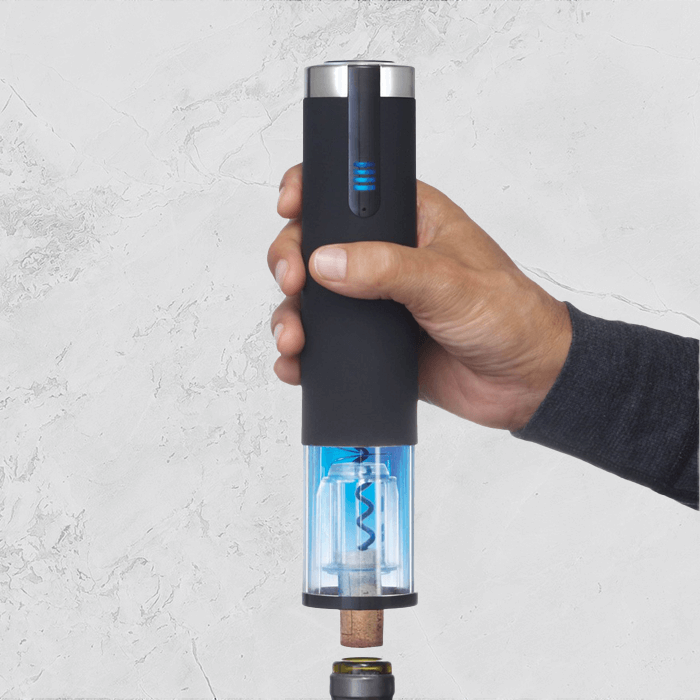
How to Use an Electric Corkscrew
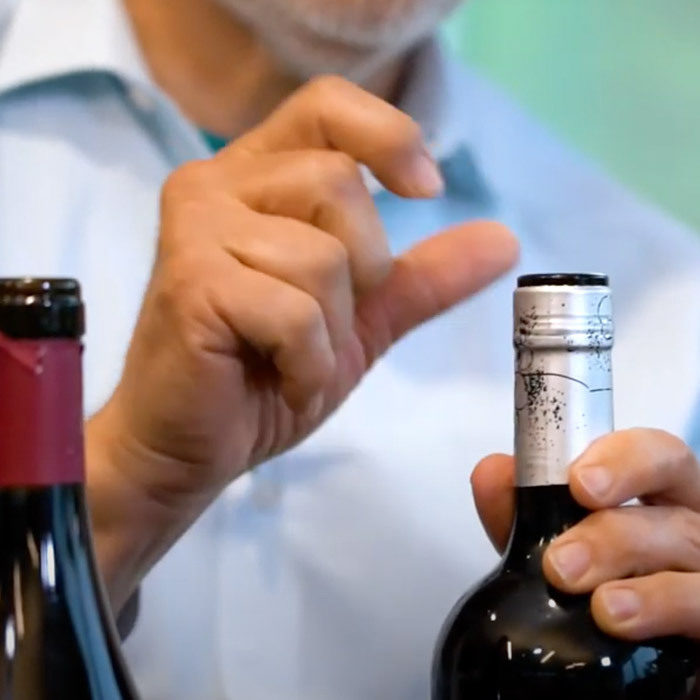
Three Simple Ways To Remove the Foil Capsule Covering the Wine Bottle
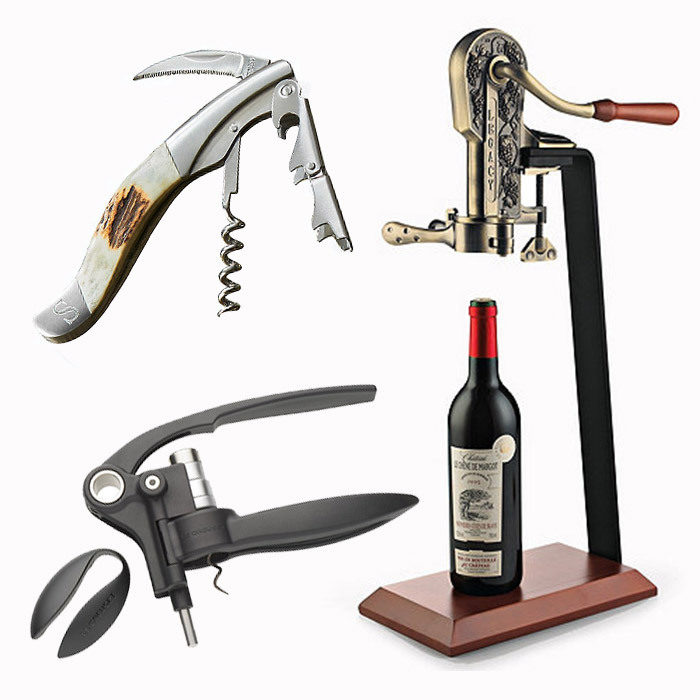
Which is the Easiest Wine Opener to Use?
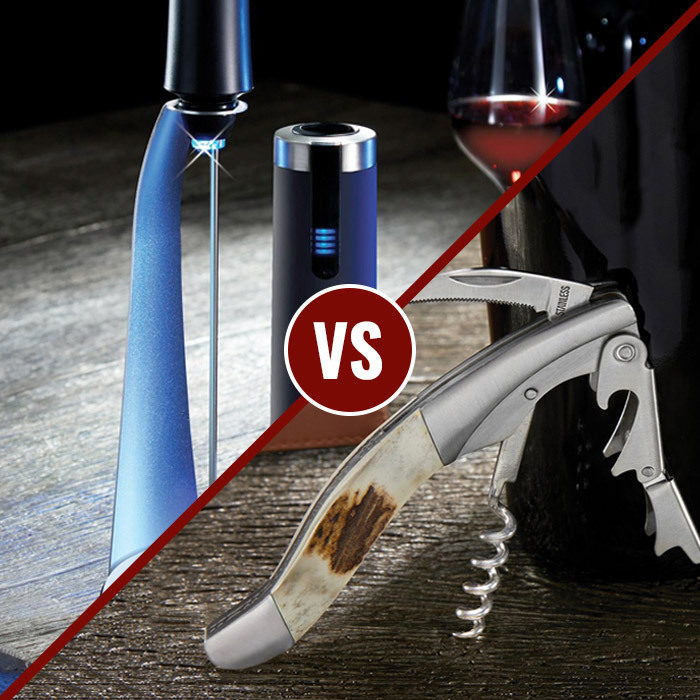
Corkscrew Showdown: Waiter’s vs. Electric Style Wine Openers
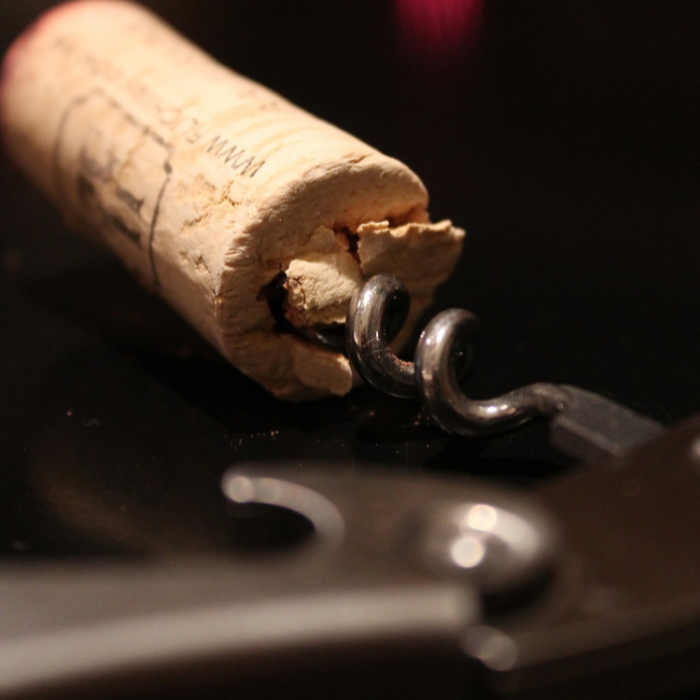
The Benefits of Each Style of Wine Opener
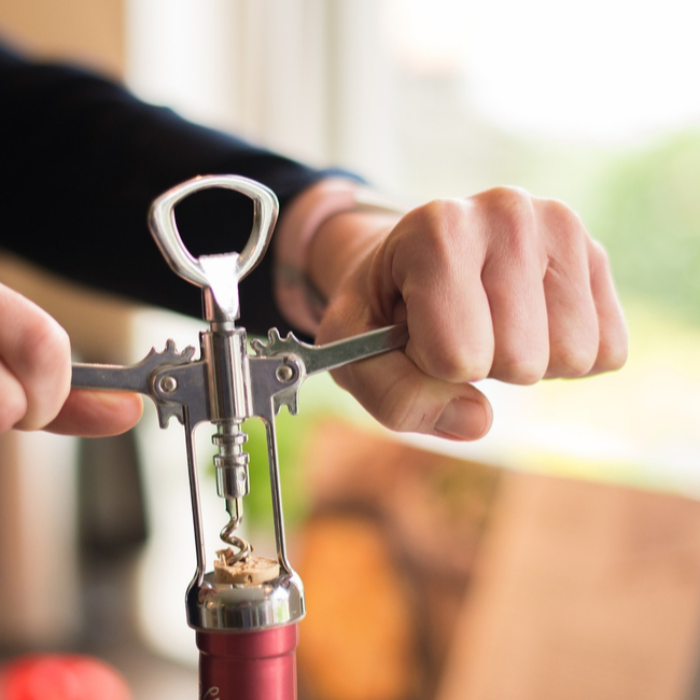
The Different Types of Wine Openers
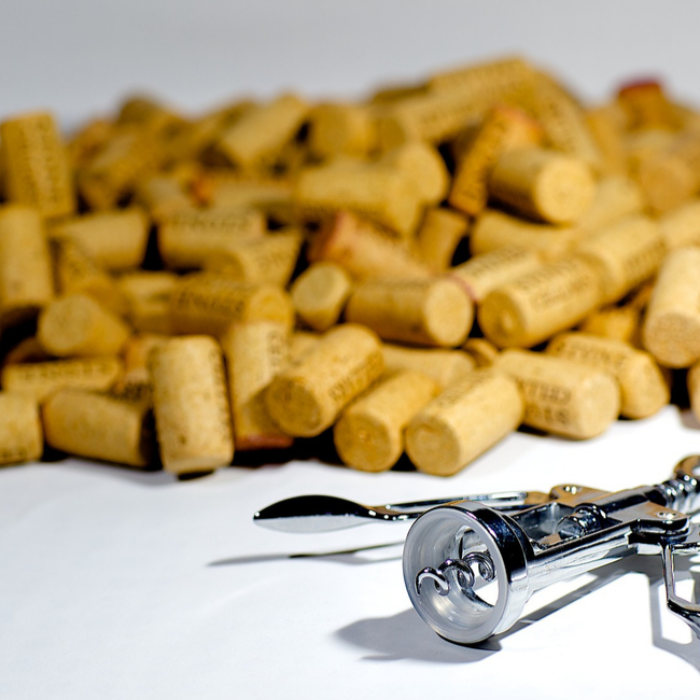
The How’s & Why’s Of Replacing Your Corkscrew Worm

Wine 101: How to Use a Waiter’s Corkscrew (Video)
While the Waiter’s corkscrew may not be the most innovative bottle-opening tool, it stands the test of time for its functionality (it just works!) and its small footprint. While electric corkscrews and lever corkscrews require less effort, the waiter’s corkscrew folds up easily and fits in a “waiter’s” pocket (no secret how its name came to be). Which means it fits nicely into your kitchen drawers without occupying counter space.
But the steps to use a Waiter’s corkscrew are not obvious to novices, so we had Josh redo one of his most popular how-to videos , originally produced in 2009
10 years later, Josh is older and wiser but the steps are the same! If you aren’t sure how to use a Waiter’s corkscrew don’t be embarrassed. Watch our under-2-minute video and follow the steps.
How to Use a Waiter’s Corkscrew:
- Press the foil cutter against the neck of the bottle and twist around the neck to remove the foil.
- Place the point of the worm into the center of the cork and start to drill down until you reach a good place where the hing hits the top of the bottle
- Rest the hinge on top and then pull the backside of the corkscrew up. The cork should pull up with you. Pull towards you rather than away to avoid bending and potentially snapping the cork.
If you have a particularly wet or dry cork and you run into a snafu where it breaks in half, don’t panic! Watch our video on How to Remove a Broken Cork and you’ll be on your way to sipping in no time!
Bill Conway
You just show video on the waiters cork screws. You have been having sales on wine cabinets, glass ware, when are the the cork screws on sale?
Leave a Reply Cancel reply
Your email address will not be published. Required fields are marked *
Save my name, email, and website in this browser for the next time I comment.
Join our mailing list! Be the first to know about fantastic wines that are sure to sell out fast!
- About Expressions
Recent Posts
- The Best Wines for Thanksgiving
- Welcome Fall with Grenache Wine
- 5 White Wines to Pair with Seafood and Summer Fare
- Charcuterie Board & Wine Pairings: How To Make Your Own Charcuterie Board
- What Is The Difference Between Vertical and Horizontal Wine Tastings?
- Announcements
- Incoming Deals
- Josh's Desk
- Pairing Challenge
- Uncategorized
- Wine Recommendations
- Wine Tastings
@WineExpress
To help us provide you with free impartial advice, we may earn a commission if you buy through links on our site. Learn more
Best corkscrew 2022: Our pick of our favourite corkscrews to open any bottle
- Ruby Martin

Looking to get the party started? Check out our guide to the best corkscrews
The best corkscrews are an essential item for any good dinner party host. A lot of the best wine is sealed with a cork, as it allows the wine to age naturally without becoming sour. To enjoy these naturally aged wines, however, you will of course need a good corkscrew – the last thing you want is to ruin your evening by shredding the cork into the wine below.
We’ve all owned a cheap and cheerful corkscrew, but if you’re looking to invest in something that’s going to last, it can be hard to know exactly what you’re looking for. Luckily, we’ve compiled a list of some of our favourite corkscrews around, so whether you’re a connoisseur looking to open a vintage or just a recent graduate of screwtops who’s stuck, we’ve got the guide for you.
Corkscrews come in a wide variety of types with a lot of different styles and features, so have a read of our buying guide to find out which kind is best for you. With our help, you’ll be prepared for whatever bottle you might come across.
The best corkscrews: At a glance
- The best budget corkscrew: Pulltap Wine Essentials Waiter’s Friend Double Lever Corkscrew | Buy now
- The best lever corkscrew: OXO Steel Vertical Lever Corkscrew | Buy now
- The best corkscrew for older bottles: Monopol Westmark Germany Ah-So Cork Puller | Buy now
- The best electric corkscrew: Cuisinart cordless 4-in-1 opener | Buy now
How to choose the best corkscrew for you
What features do i need.
There are a couple of different features you can get depending on your needs. These will depend on your general dexterity – if you are older or suffer from joint problems, you should seek out corkscrews that don’t rely on a twisting mechanism., This is to consider in addition to what kind of bottles you are opening and how old the bottles, and therefore their corks, are. The following are the most common types of corkscrew; each one will suit different needs.
Waiter’s corkscrew: A lightweight corkscrew that’s characterised by its ability to fold up neatly and slip into a pocket. Originally used by waiters in bars, it will also have a foil cutter and a beer bottle opener in order to open most kinds of bottles. Even if you don’t work in a bar, however, you can appreciate this corkscrew’s versatility; it’s perfect for staying in or taking out if you fancy drinking alfresco style.
Who is it for? People who open a lot of different kinds of bottle, both at home and out and about.
Winged Corkscrew: This classic corkscrew design uses a pair of “wings” that raise as you twist the screw into the cork. Once the screw has a firm grasp, you simply push both wings downwards, and both screw and cork pop out. Generally very cheap but less compact than the waiter’s friend, this is an affordable at-home staple.
Who is it for? People on a budget, who otherwise have a tendency to lose things.
Continuous pull corkscrew: This is very similar to the winged corkscrew in terms of the method of opening, which involves puncturing the cork and twisting. The only difference is that they don’t have wings, so they tend to have a sleeker design. Good for a robust and more ergonomic option.
Who is it for? Those considering a winged corkscrew but value storage space.
Lever corkscrew: Perhaps the most straightforward to use, you slot the corkscrew in, push the lever down, and when you pull the lever back out, it takes the cork out with it. Very simple and requires little effort. While pricier than the winged and waiter corkscrews, this is excellent if twisting isn’t really feasible but you don’t want to splash out on an electric one.
Who is it for? People who have difficulty with twisting motions, but are also concerned about their environmental impact.
Electric corkscrew: As the name suggests, these wine openers are powered entirely by electricity, so are no effort at all to use. All they require is to align your bottle properly before pressing a button and voila, drinks for everyone. They are pricier than the others and will require charging, so you have to be prepared and are far less transportable than other options.
Who is it for? Those who need a bit of assistance removing stubborn corks from bottles and don’t mind paying a premium.
How much should I spend?
Corkscrews can vary wildly in price depending on the model and can be anywhere from £5 to £200. Manual varieties like winged and waiters tend to be towards the lower end of the spectrum, but if you want your corkscrew to last longer, it is worth investing a little more. For any of the manual varieties, if you have a bit of money to spend, we recommend spending around the £20 to £50 range for a more sturdy model, but if you’re looking at something that requires electricity or gas, expect to pay higher than that.
READ NEXT: The best chef’s knives to buy
The best corkscrews to buy from £6
1. beneno premium wing corkscrew: best winged corkscrew.

If you’re looking for a great version of a classic, then the Beneno Premium Wing is an excellent fit. With a sturdier build than your average winged corkscrew, the Beneno also boasts not only a capped bottle opener, but wings that are fitted with a soft grip to make pulling them down that much easier. And best of all, if you have any problems with it, it comes with a lifetime warranty. Being a winged corkscrew, it isn’t as compact or pretty as some of the others, but if you want a reliable corkscrew that is far less easy to lose – this is a great choice.
Key Specs – Material: Zinc; Accessories: beer bottle opener; Electric: no

Wine Bottle Openers, BENENO Zinc Alloy Premium Wing Corkscrew Wine Opener with Multifunctional Corks and Caps Bottle Opener, Silver
2. pulltap wine essentials waiter’s friend double lever corkscrew: best budget corkscrew.

The waiter’s friend is usually the most popular kind of corkscrew, and with this model, it’s not hard to see why. This nifty gadget is both extremely reliable and affordable – perfect if you need practicality on a budget. The double hinge means it can be used to pull out both short and longer corks, and the corkscrew has been coated in Teflon for less friction when pulling, which reduces potential cork breakages. You can get much fancier and more stylish versions of the waiter’s friend, but it will be tough to find any that can beat this little number on performance.
Key specs – Material: stainless steel; Accessories: bottle opener, foil cutter; Electric: no
Buy now from WineWare
3. Monopol Westmark Germany Ah-So Cork Puller: Best corkscrew for older bottles

With older bottles, the corks can become fragile and crumbly, which means an average corkscrew won’t do. This is where the Monopol Cork Puller comes in. The two prongs are designed to straddle either side of the cork, meaning you can gently pull it out without risk of breaking. It’s deceptively basic: not only can the prongs also be used to recork bottles, but the top doubles up as a bottle opener. It can take a bit of practice to use and If you’re looking for a corkscrew that comes with lots of accessories, this isn’t the one for you. However, if you’re a fan of vintage bottles and want something stylish and reliable, this is a necessity.
Key specs – Material: Die-cast zinc, steel; Accessories: Protective cover, bottle opener; Electric: no

Westmark Bottle Opener/Corker, Monopol Edition, die-cast steel/zinc, Ah-So, chrome-plated, 6285336C
4. oxo steel vertical lever corkscrew: best lever corkscrew.

If grappling with a twist-operated corkscrew isn’t an option for you, this is an excellent alternative. This lever corkscrew is not only very straightforward to use, but has soft non-slip grip to make sure it’s extra comfortable when handling, unlike a lot of the metal corkscrews on the market. The additional foil cutter neatly slots into the opener for convenient storage. This is a little pricier than the other kinds of manual corkscrew and the foil cutter can become a little loose when knocked. However, if you’re looking for an accessible and eco-friendly corkscrew, this is perfect for you.
Key specs – Material: alloy steel; Accessories: foil cutter, extra non-stick screw ; Electric: no

OXO Vertical Lever Corkscrew with Removable Foil Cutter, Steel, Silver, 18.7 x 18.7 x 6.1 cm
5. le creuset: best continuous pull corkscrew.

Le Creuset is known for its reliable kitchenware and this corkscrew is no exception. Incredibly popular among customers, it’s very simple and easy to use, with its sleek form slotting neatly on the top of the bottle. Unfortunately, unlike other Le Creuset products, it is less chic, as it is only available in one colour, and it has a plastic body rather than the usual metal or ceramic which feels less robust to hold. It’s not too difficult to twist however, which is good news for those with joint problems. And having spent twenty years on shop shelves, it comes with an unofficial assurance of quality – and longevity.
Key specs – Material: nickel; Accessories: none; Electric: no


Le Creuset Wine Accessories Table Model Corkscrew, TM-110, Black, 59993013407261
6. cuisinart cordless 4-in-1 opener: best electric corkscrew.

This impressive device from Cuisinart might be on the pricey side but it’s the perfect gift for the wine lover in your life – whether that’s yourself or a friend. It automatically detects and opens wine bottles once the head is placed over the cork, but it’s so much more than just a cordless, automatic opener. There’s also a pick to quickly and easily remove pesky foil lids, as well as an aerator and vacuum-sealed bottle stopper too.
It’s a bit tricky to get the hang of the first time you use it – you have to hold the device still as it’s drilling into the cork or it just spins around menacingly. Once you’ve got this down though, it works incredibly well and opens up to 50 bottles of wine on just one two-hour charge. What’s more, it’s not too bulky and the slick silver design looks fab in modern kitchens.
Key specs – Material: titanium; Accessories: foil cutter, aerator, dated bottle stop; Electric: yes, rechargeable
Buy now from Very
7. Coravin Timeless Three: Best luxury corkscrew

Technically this is a corkscrew that doesn’t actually remove the cork, but it’s better than it sounds. The model uses a small needle to puncture the cork, allowing the wine to come out before using argon gas to prevent the remaining wine from oxidising. If you spend an extra £30, you can also get a unique Coravin aerator that aerates your wine as you pour.
While this is a great way to not only open but preserve your wine, the obvious downside is the price tag. It’s significantly more expensive than any entry on this list and on top of the initial expense you have to buy replacement argon canisters. If you’re looking for a slightly cheaper method of preservation, there is the Coravin Pivot , that instead of puncturing the cork, replaces it after removal with a stopper. It is £80 cheaper, but can only extend the wine by four weeks instead of months or years with the Timeless Three. If you’re looking for longevity, the Model Three is the way to go.
Overall, the Coravin Timeless Three is a great investment for those who are very, very serious about their wine.
Key specs – Material: stainless steel, fiberglass nylon; Accessories: needle clearing tool; Electric: no
The Best Wine Openers of 2022, According to Experts and Reviewers
These can handle even the oldest wine corks.
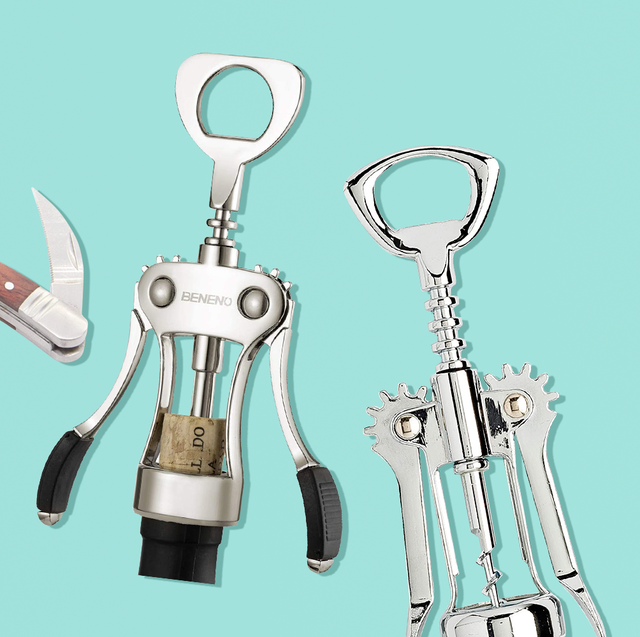
We've been independently researching and testing products for over 120 years. If you buy through our links, we may earn a commission. Learn more about our review process.
When selecting the best wine opener for you, it's important to consider what you value most in the little kitchen gadget . It might sound silly to put any thought into it, but it's helpful in the long run since you'll end up keeping it for a while. Here are a few examples of popular wine opener styles to help:
- Winged corkscrew: Just as its name hints, this corkscrews has two arms or "wings" that shoot up during cork removal. These classic wine openers are popular for their small profile and general reliability. "I like its classic style and the fact that it works," says Nicole Papantoniou , senior testing editor and producer of the Kitchen Appliances Lab.
- Electric wine opener: These days, most electric wine openers come cordless with a charging stand, and promise the ability to open several bottles of wine on a single charge. " These are great for people with limited mobility," says Papantoniou.
- Waiter's corkscrew: This style is compact in size and popular for on-the-go. "The two joints are what's key to the waiter's corkscrew — this allows for better leverage," says food editor Catherine Lo . " While I have some higher-tech wine openers, I always turn back to my waiter's corkscrew since it's durable and easy to stash in a tote bag," adds Samantha MacAvoy, editorial assistant at the Test Kitchen.
- Lever corkscrew: Simply push down and pull up with this wine opener. It requires a bit of arm strength, but the two-motion mechanism is attractive to those who want a seamless experience.
See below for the best wine openers , according to Good Housekeeping editors and experts, plus a few top-rated picks from online reviews so you can enjoy your bottle of rosé in peace.
Beneno Wing Corkscrew Wine Bottle Opener

This oldie-but-goodie is well loved by reviewers, many saying it's designed with a "high-end atmosphere" when it only costs $12. What really makes it stand out are the rubber grips that make for a more comfortable opening process. "With a corkscrew like this one, I don't have to compromise ease of use or performance," Papantoniou says.
Cooking Light All-in-One Winged Corkscrew
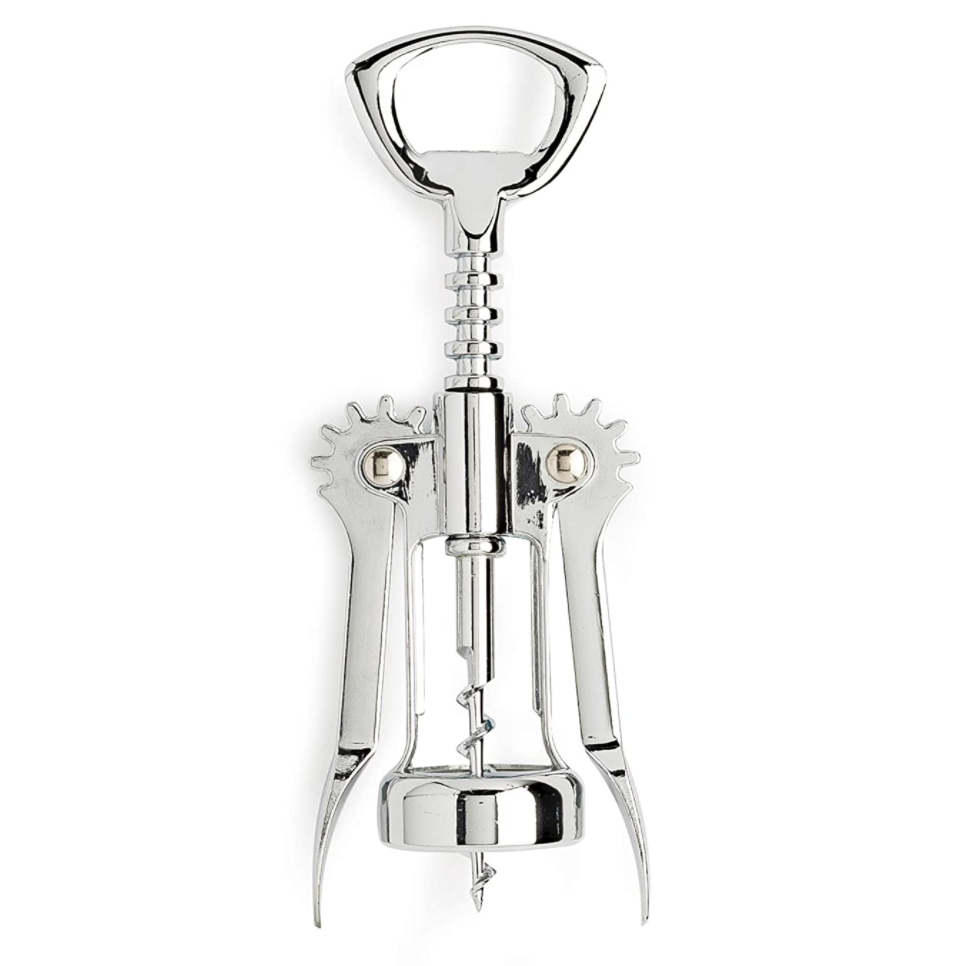
Made of all stainless steel, this corkscrew is no-frills and easy to clean. "I like something that takes up the least space in my drawer," says Lynn Redmile , Testing and Product Review Analyst at the Good Housekeeping Institute, "and that's why I've been using my winged opener for more than a decade." This corkscrew style has a bottle opener at the end, making it useful for cracking open a beer or soda too.
Belwares Ah-So Two-Prong Cork Puller
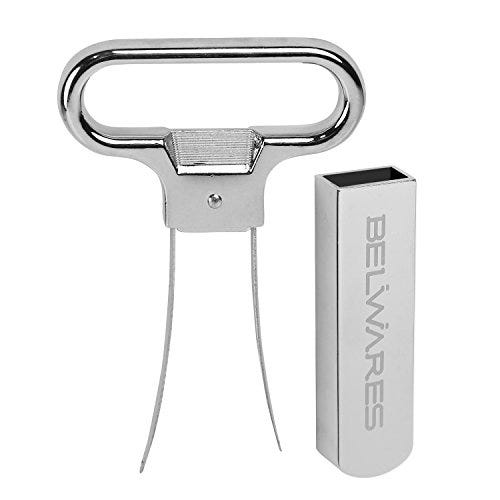
"The Ah-So style really works well for crumbly, problem corks ," says Lo. How it works: Stick one prong on either end of the cork, wedge the wine opener down into the bottle until it encapsulates the entire cork, and twist upwards until the cork is out. You can even use the same process to cork the wine bottle.
Pulltex Pulltap's Classic Corkscrew
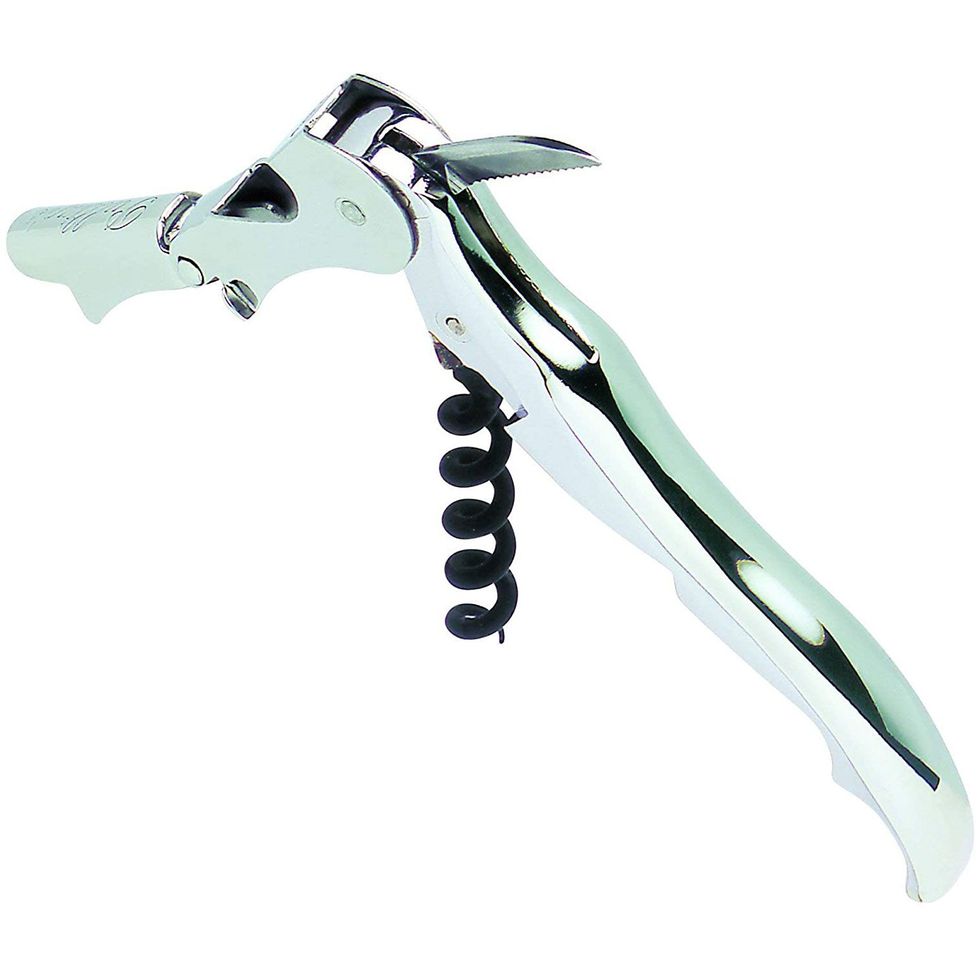
A few of our experts agreed that they can count on their trusty Pulltap corkscrew, and online reviewers say " the design facilitates even the most difficult cork extractions ." The corkscrew is made of sturdy steel, but it folds up to take up less space in your kitchen drawer.
Rabbit Wine Corkscrew with Foil Cutter
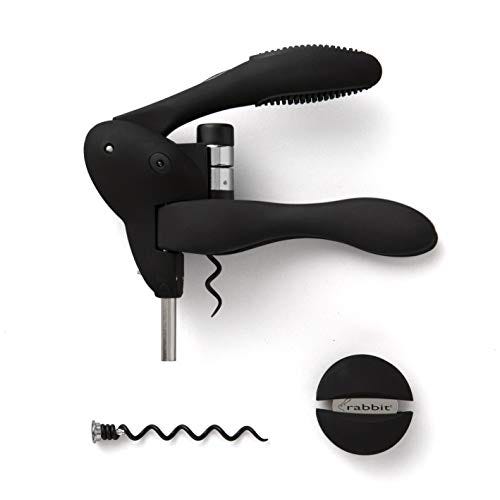
Rabbit is one of the most-sought after wine openers on the internet, probably because of its professional design and claim to eject a cork out in just three seconds flat. Even our experts agree that the tool is easy to use, but some complain that it can be challenging to store away.
Oster Cordless Electric Wine Bottle Opener
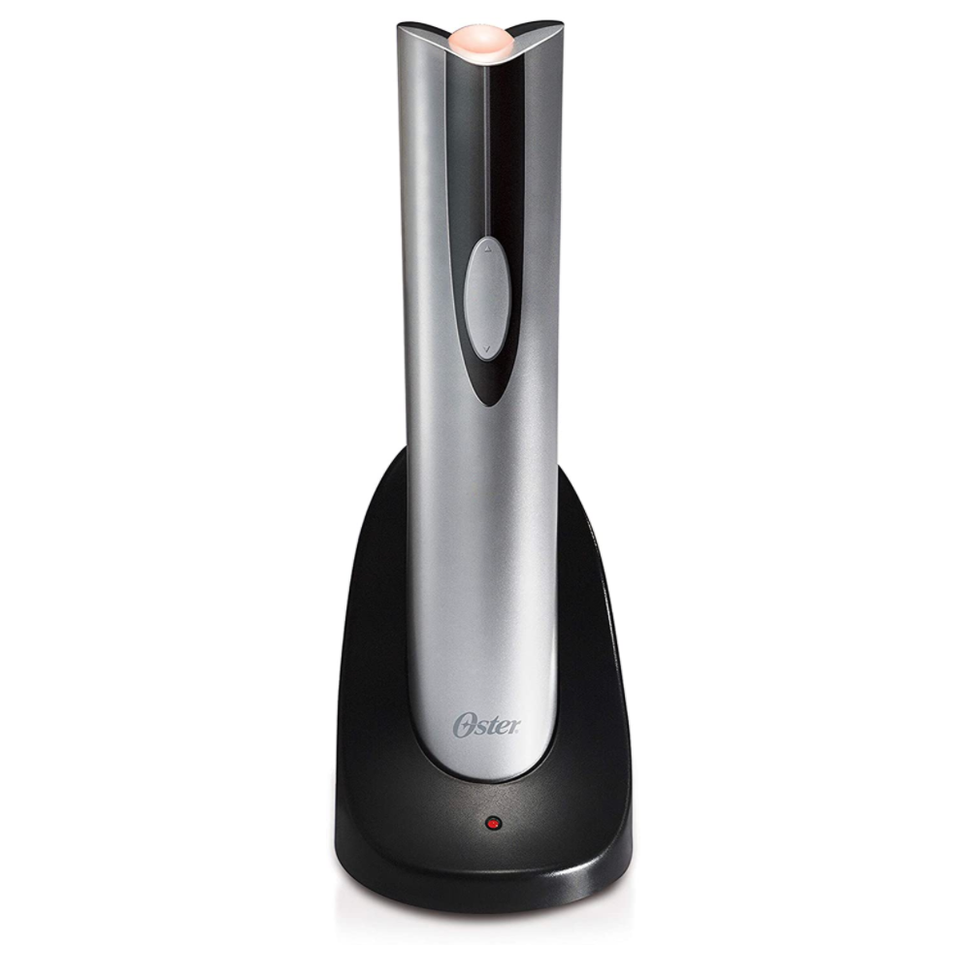
The brand claims that this electric wine opener can open up to 30 bottles on a single charge. It's cordless but its base can also be plugged in all the time, making it ready for use whenever you need. Reviewers like that the handle is slim and comfortable to grip.
Brabantia Classic Corkscrew Bottle Opener
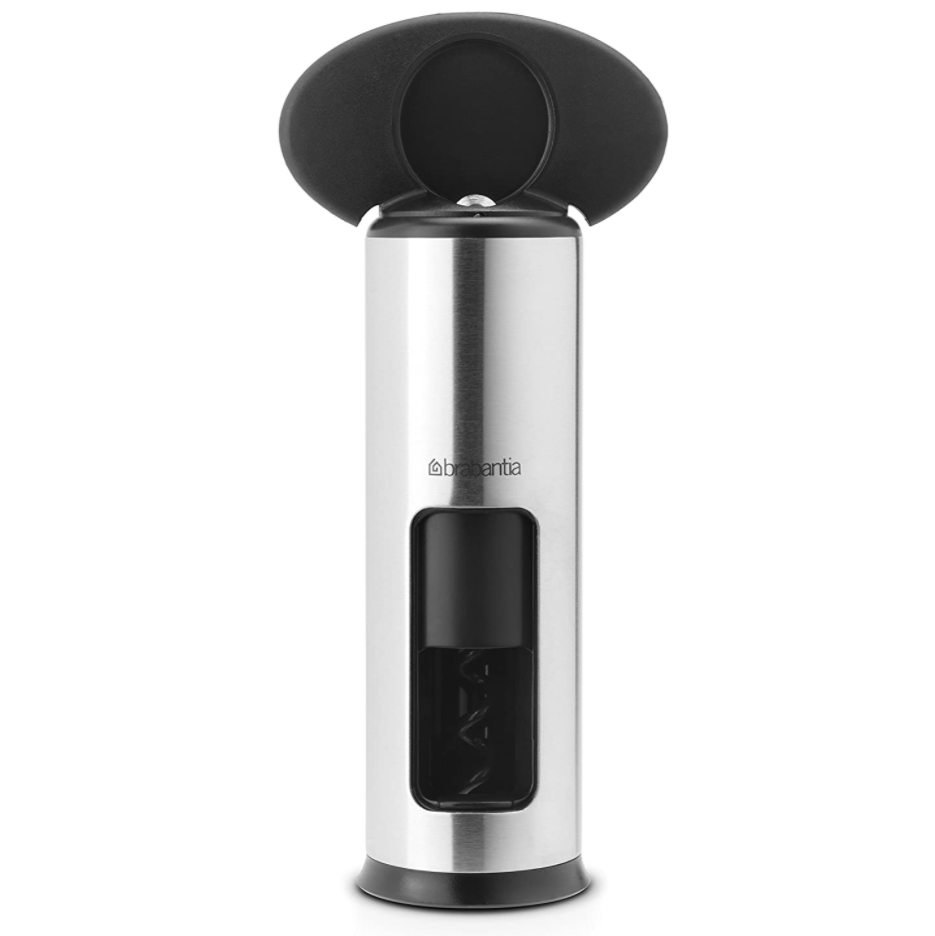
If you need something that requires little to no effort, Carolyn Forte , director of the Cleaning Lab, recommends this corkscrew. "It's my absolute favorite and it hasn't failed me yet," she says. To use, simply turn the corkscrew in one direction until the cork pops out. Reviewers add that it's a great choice for those who deal with arthritis or might not be as strong.
Le Creuset Original Table Model Wine Opener
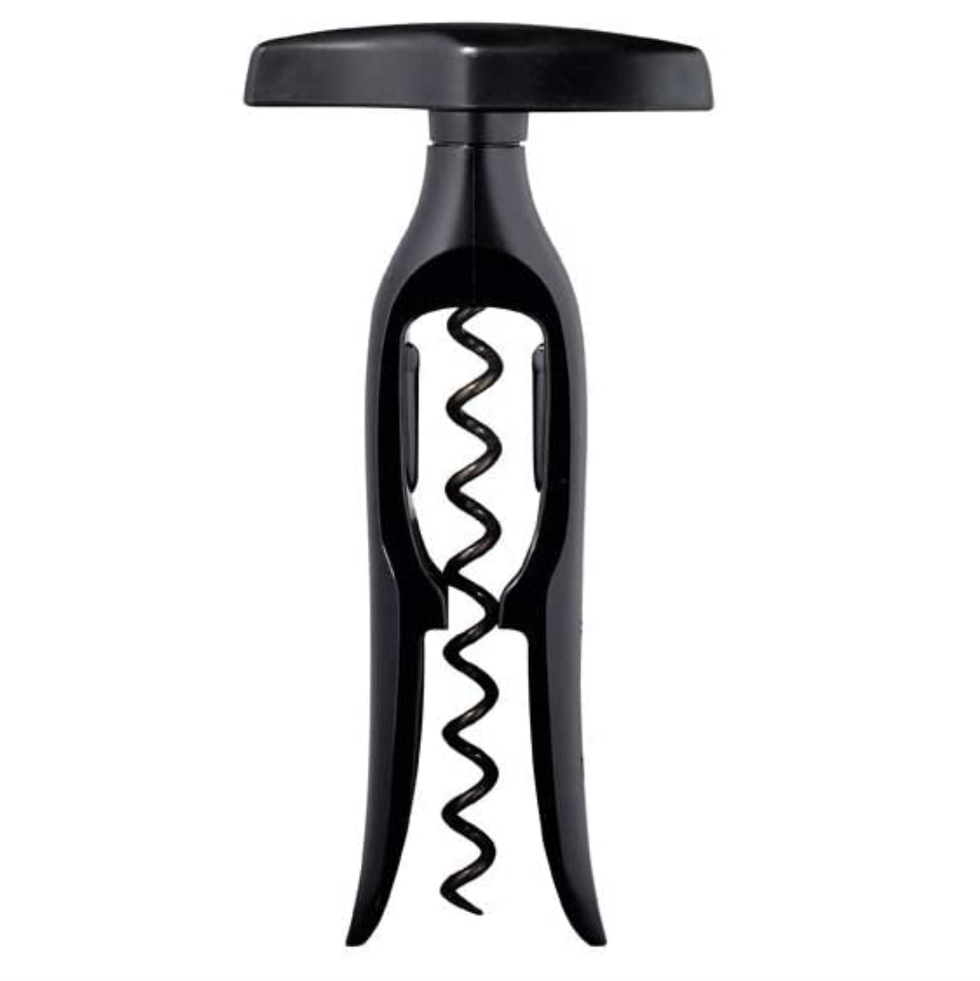
The timeless, sleek design makes this Le Creuset pick popular among reviewers. It's basically the more modern version of the traditional twist corkscrew . The nearly 5-inch spiral worm is said to tackle corks of any size.
Trudeau Laguiole Stablewood Portable Corkscrew
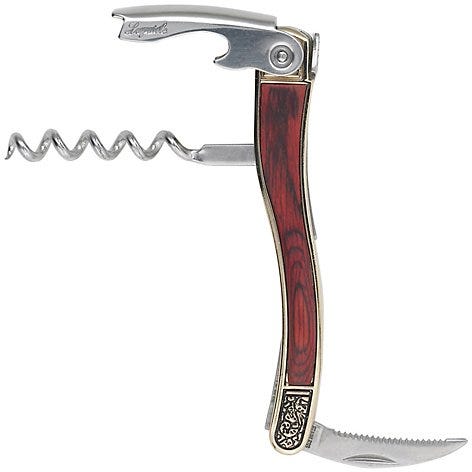
GH Institute director Laurie Jennings prefers the Languiole corkscrew style because she finds that the longer spiral worm allows for more control. "This method requires a little more muscle, but it's less likely to harm the cork if you want to re-bottle," she says. It also boasts a lavish design, so it's a corkscrew you won't want to lose.
OXO Vertical Lever Corkscrew
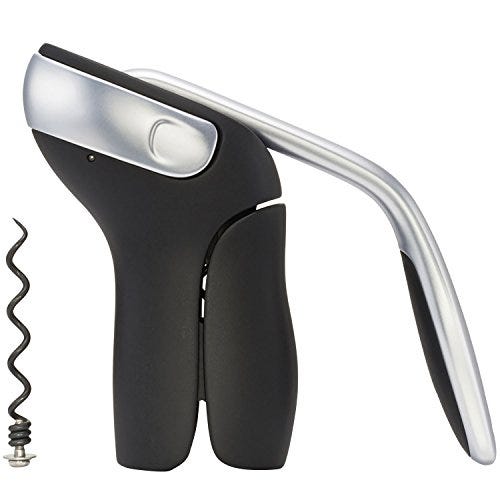
This lever corkscrew removes corks with two motions : Push down to pierce the cork and pull up to release it. "It's extremely easy to use and no hassle," says Stefani Sassos , GH's Registered Dietitian Nutritionist. It also comes with a removable foil cutter that stores right onto the corkscrew itself.
Brookstone Compact Wine Opener
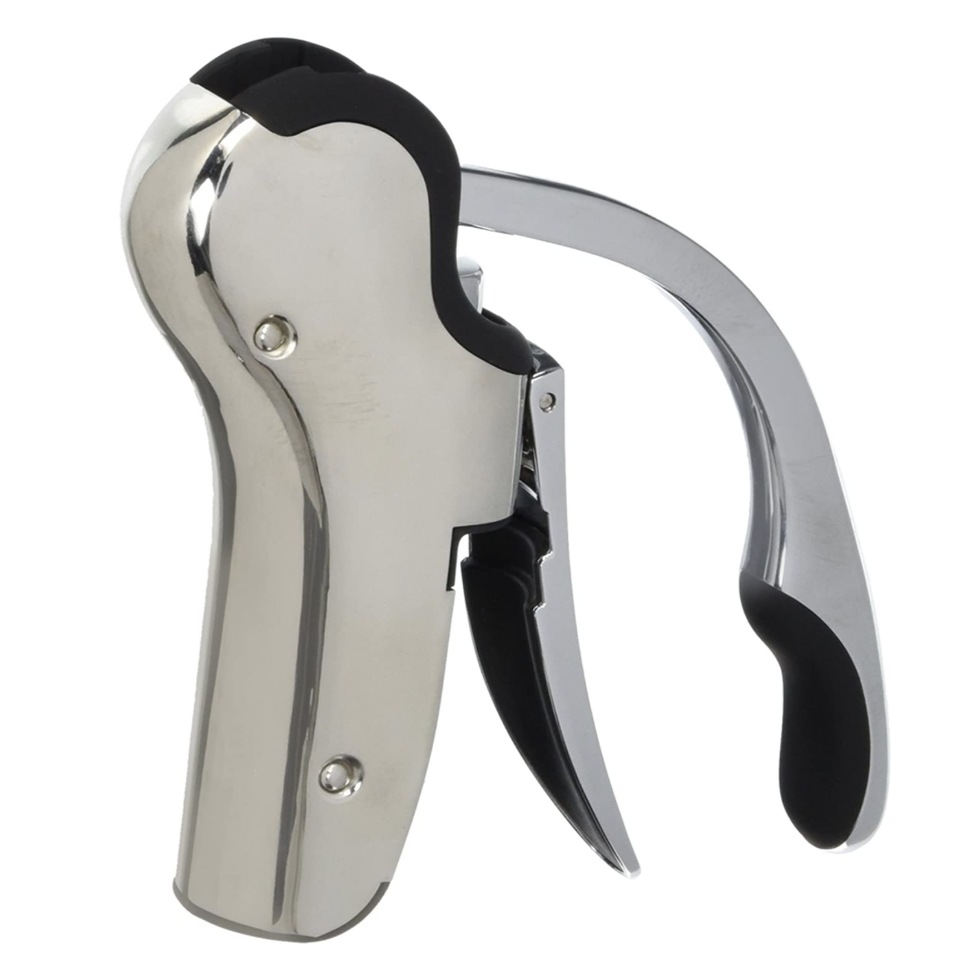
Nearly 1,000 Amazon reviewers gave this wine opener a perfect star rating; plus it's a top-searched wine opener online. According to the brand, it can open any wine bottle in a matter of three seconds. Reviewers say the wine opener is durable and has a "solid feel" that feels like it would last a while.

Shanon is a writer and editor who specializes in best-of product roundups and deals. She has over six years of experience, including almost three years as a Good Housekeeping product and reviews editor, covering the best sales and products across home, appliances, health, beauty, parenting and more.

@media(max-width: 64rem){.css-o9j0dn:before{margin-bottom:0.5rem;margin-right:0.625rem;color:#ffffff;width:1.25rem;bottom:-0.2rem;height:1.25rem;content:'_';display:inline-block;position:relative;line-height:1;background-repeat:no-repeat;}.loaded .css-o9j0dn:before{background-image:url(/_assets/design-tokens/goodhousekeeping/static/images/Clover.5c7a1a0.svg);}}@media(min-width: 48rem){.loaded .css-o9j0dn:before{background-image:url(/_assets/design-tokens/goodhousekeeping/static/images/Clover.5c7a1a0.svg);}} Cooking Tools

The Best Sous Vide Machines
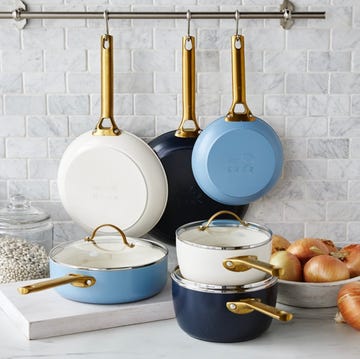
Our Honest Review of GreenPan Cookware
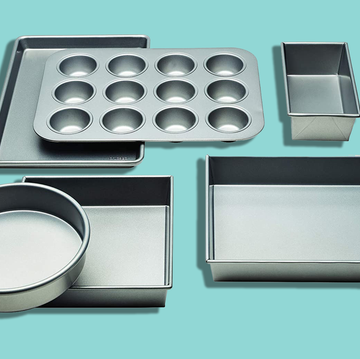
The Best Baking Pan Sets
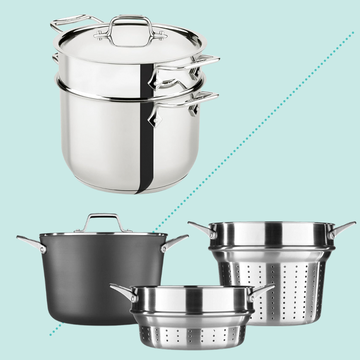
The Best Pasta Pots
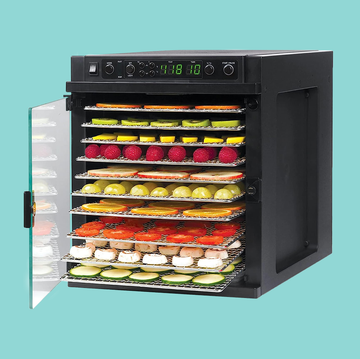
The Best Food Dehydrators
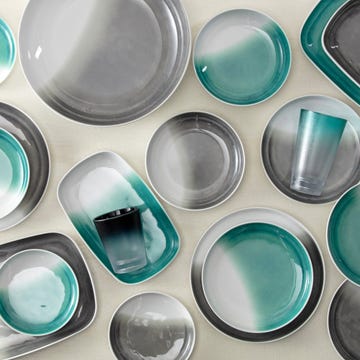
3 Kitchen Gear Trends We Can't Stop Talking About
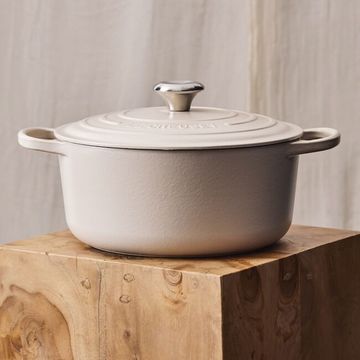
Why Le Creuset's Dutch Oven Is Worth the Money
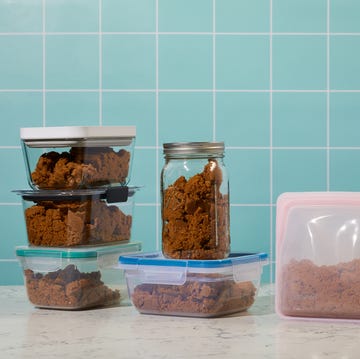
The Best Food Storage Containers
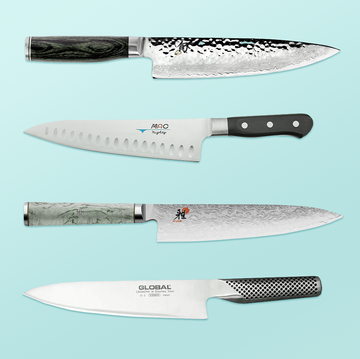
The Best Japanese Knives
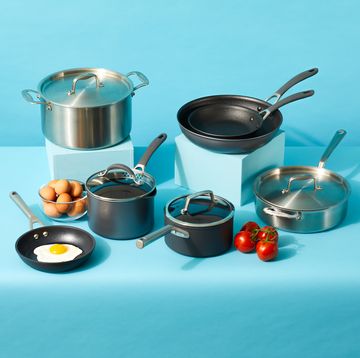
The Best Nonstick Cookware

The Best Egg Pans
Winemakers Corner
Your resource for home winemaking, wines, and brewing.
How To Use A Wine Corkscrew
Becoming proficient at operating a wine corkscrew might seem intimidating, especially for novices such as me. However, through consistent practice and a bit of patience, I’ve managed to perfect this skill and can now effortlessly …
Written by: John Ward
Published on: April 13, 2024

Becoming proficient at operating a wine corkscrew might seem intimidating, especially for novices such as me. However, through consistent practice and a bit of patience, I’ve managed to perfect this skill and can now effortlessly uncork a bottle of wine. In this piece, I aim to guide you through the detailed procedure of maneuvering a wine corkscrew, while offering some personal advice and observations I’ve gathered along the way.
Step 1: Choosing the Right Corkscrew
Before you begin, it’s crucial to have the right tool for the job. There are several types of corkscrews available, but the most common one is the waiter’s corkscrew. It consists of a spiral worm, a lever, and a small knife. I prefer this type because it’s compact, easy to handle, and gets the job done efficiently.
Step 2: Preparing the Bottle
Now that you have your corkscrew ready, it’s time to prepare the wine bottle. First, remove the foil or any covering from the top of the bottle. This will expose the cork and make it easier to work with. Make sure to wipe any dirt or dust from the top of the bottle before proceeding.
Step 3: Inserting the Worm
Hold the wine bottle firmly in one hand, and with the other hand, position the tip of the worm at the center of the cork. Apply gentle pressure and begin twisting the worm clockwise, pushing it into the cork. Keep rotating until the worm is fully inserted, leaving only one or two rotations visible.
Step 4: Leveraging the Cork
Once the worm is securely in place, it’s time to leverage the cork out of the bottle. Hold the wine bottle and corkscrew firmly. Extend the lever arm and place it on the lip of the bottle. Using the leverage, gradually lift the cork out of the bottle. You may hear a satisfying “pop” sound as the cork comes out.
Step 5: Removing the Cork from the Worm
After successfully extracting the cork, carefully remove it from the worm. Some corkscrews have a small notch or groove near the handle that allows you to hold the cork while turning the screw counterclockwise. Take your time to ensure the cork doesn’t break or crumble, as this can impact the taste and enjoyment of the wine.
Step 6: Pouring and Enjoying
With the cork removed, it’s time to enjoy the fruits of your labor. Hold the bottle at a slight angle and pour the wine into your glass. Take a moment to appreciate the aroma and color of the wine before taking your first sip. Cheers!
Using a wine corkscrew may seem daunting at first, but with practice, it becomes second nature. Remember, the key is to be patient and gentle throughout the process to avoid any mishaps or accidents. So, grab your favorite bottle of wine, follow these steps, and savor every moment of the experience.
Opening a bottle of wine with a corkscrew is an essential skill for any wine enthusiast. With the right tools and a little practice, you’ll be able to effortlessly uncork your favorite bottles and enjoy the rich flavors within. So go ahead, embrace the art of using a corkscrew, and elevate your wine-drinking experience.
About John Ward

Have you ever questioned the reason behind the small opening on wine bottles, sealed with a cork or screw cap? Read more

I recently had the opportunity to visit a stunning vineyard and I must say it was truly magical. The moment Read more

When it comes to making wine, a vital part of the process is knowing when fermentation is finished. As someone Read more

I have a distinct memory of the initial occasion when I tasted a glass of port wine. It was a Read more
How To Use An Electric Wine Opener
De la rosa wine.
- Share full article

The 25 Essential Pasta Dishes to Eat in Italy
Two chefs, one cookbook author, a culinary historian and a food writer made a list of the country’s most delicious meals, from carbonara in Rome to ravioli in Campania.
Credit... Enea Arienti
Supported by
By Deborah Dunn , Vicky Bennison , Marianna Cerini , Robyn Eckhardt , Laurel Evans , Kristina Gill , Andrew Sean Greer , Lee Marshall , Elizabeth Minchilli , Marina O’Loughlin , Katie Parla , Rachel Roddy , Eric Sylvers and Laura May Todd
Photographs by Enea Arienti
- May 17, 2024
For a food that begins with just flour, water or sometimes eggs, there are infinite variations of pasta. So what happens when you convene a panel of five Italian cuisine experts and ask them to determine the 25 most essential pasta dishes throughout Italy? “I’m sweating,” said Davide Palluda, the chef and owner of All’Enoteca restaurant and osteria in the Piedmont region. “This is too heavy,” he joked during the two-hour video call that I convened to debate his nominations and those of the four other panelists: Stefano Secchi, the chef and a co-owner of New York City’s Rezdôra ; the Tuscany-based cookbook author Emiko Davies ; the Umbria-based culinary historian Karima Moyer-Nocchi ; and the food writer and novelist Roberta Corradin, who lives in Florence, Sicily and Boston. A week before our call, I’d asked each to make their own list of 10 standouts (since he was a panelist, Palluda’s restaurants were automatically excluded); after an energetic debate and several more phone calls, emails and WhatsApp messages, we whittled that list in half. The final picks appear below in unranked alphabetical order, along with the ideal wine to drink with each pasta dish, as recommended by the chosen restaurants and reviewed by Davies’s husband, the sommelier Marco Lami.
This list is the latest in our T 25 series , which highlights significant achievements in the worlds of design, literature , fashion, architecture and food . Previous debates about where to eat right now were confined to major cities like Paris and Mexico City , but this time around, we wanted to see what we might learn if we surveyed the culinary landscape across an entire food-crazed country. We chose pasta because it’s the food most associated with Italy, and because it’s the subject of T’s new Travel issue . It’s also the staple that reveals just how much Italian cooking, even in 2024, remains firmly anchored to a specific place. While most countries have regional fare, Italy is particularly fixated on a recipe’s exact provenance — the town, the valley, the strip of coastline — which is why you’ll often find different pasta shapes or sauces, even over the span of just a few miles.
This culinary diversity informed many of the panelists’ decisions: sometimes, they opted to include a dish because it’s rarely made beyond its birthplace (see Lombardy’s pizzoccheri, No. 12); other times, they chose a favorite sauce (for example, carbonara) or simply a type of pasta like strangozzi (typical of Umbria) since it, like so many local specialties found in the countryside, is paired with different ingredients depending on the time of year.
Only two specific dishes were nominated by more than one panelist: the agnolotti del plin at Madonna della Neve in the Piedmont and the vincisgrassi at Osteria dei Fiori in the Marche region, both centuries-old dishes served at decades-old restaurants. The classics, in general, came up again and again. Even the more idiosyncratic dishes that merited inclusion were riffs on familiar fare: Secchi, for example, made an impassioned plea for the dish called the Crunchy Part of the Lasagna, the chef Massimo Bottura’s technical take on the beloved casserole, offered at his Francescana restaurant at Maria Luigia in Modena, Emilia-Romagna. “If we’re talking about transcendent pasta experiences, that’s it,” Secchi said. (Lasagna, in fact, made a strong showing on this list, which features three varieties.) Secchi suggested one reason the old favorites took primacy: relentless demand.
Northern and central Italy are also overrepresented, perhaps because that’s where most of the participants are based, though Corradin argued that she could easily make an entire list dedicated to any region. And Palluda worried about omitting gnocchi, though there was some disagreement about whether the dumplings usually made with potato and flour are even considered pasta. But Corradin had the final word: “No. Gnocchi is gnocchi. It’s a different chapter. Next time.” — Deborah Dunn
The interview portion has been edited and condensed.
1. The Agnolotti del Plin at Ristorante Madonna Della Neve
Cessole, piedmont.

Overlooking the Bormida valley, Ristorante Madonna della Neve sits opposite the 16th-century chapel for which it’s named. With large windows framing bucolic views, its classic osteria ambience is echoed in its menu of time-honored dishes. While agnolotti is a term used for many kinds of stuffed pasta, especially in Italy’s northwestern Piedmont region, it’s the agnolotti del plin — penny-size filled pasta that’s named for the pinch with which it’s sealed (“pinch” is plin in the Piedmontese dialect) — that are the real star. The manager, Piermassimo Cirio, whose grandparents opened Ristorante Madonna della Neve in 1952 and who sometimes heads up the kitchen, says that meeting the demand for agnolotti del plin requires a full day of filling and folding each week from a crew of staff and family members. And for many guests, the pasta — which is filled with a mixture of ground veal, pork and rabbit, Parmigiano-Reggiano, rosemary and borage — is, in itself, a multicourse meal. Start with the version served al tovagliolo, meaning on a linen napkin without sauce, allowing the gentle sweetness of the filling’s leafy greens to shine. Follow with agnolotti with sage and butter or, more bracingly, sage and lemon juice (Cirio’s invention). Next, try them with a sauce of Bolognese-ish ragù or, as an alternative, the juices and tender scraps of a beef roast (arrosto). For a final course, order a small bowl of agnolotti doused with Barbera wine. Suggested wine pairing: Isolabella della Croce Maria Teresa Barbera d’Asti 2022. — Robyn Eckhardt
2 Reg. Madonna della Neve
Roberta Corradin: I grew up in Piedmont and homemade agnolotti with a roasted meat filling is mandatory.
Karima Moyer-Nocchi: Madonna della Neve is an incredible experience.
Stefano Secchi : I was just there last year and it’s fantastic.
Davide Palluda: I took a picture with the almost 90-year-old [Piera Cirio, Piermassimo’s mother] a few years ago, and I asked her how many agnolotti she’s made in her life. I think a million. She has the forearms! She’s the one that [reminds] all the young chefs in Piedmont why we have to respect [the traditions]. The nicest way to have it is just boiled and naked, without sauce.
Moyer-Nocchi: Oh, yeah, that’s gorgeous. It’s homey and nurturing, and that humble way that it’s served makes it a transformative experience.
2. The Busiate at Duomo
Ragusa ibla, sicily.
The Sicilian chef Ciccio Sultano calls the busiate, an elegant but sturdy corkscrew pasta shape that was historically formed by wrapping the dough around knitting needles (or the stem of a local grass) , “matriarchal.” It’s a specialty of Trapani, on Sicily’s west coast, and usually served with pesto Trapanese: almonds, basil, garlic, tomatoes, pecorino, perhaps a touch of fresh mint. But at Duomo, a gastronomic institution in Ragusa Ibla, on the southern end of the island, Sultano goes much further, imbuing the pasta (always made in-house from heritage grains such as tumminia and perciasacchi) with intense local flavors. The busiate on the current menu features fragrant wild fennel and saffron and a ragù of glittering anchovies and mackerel. And to finish: grated red tuna heart. Another longtime favorite version, which resurfaces from time to time, is the busiate kneaded with rosewater and topped with plump, sweet Mazara prawns (pictured above). Opened nearly 24 years ago, Duomo, as the name suggests, sits in a handsome townhouse down the street from Ragusa Ibla’s dramatic Baroque cathedral, less than an hour from where Sultano took his first job in a kitchen, at a pastry shop, when he was just 13. Eating this dish, he suggests, evokes the island life, culinary influences via Sicily’s many centuries of invaders, from the Greeks and Arabs to the Normans, and the voluptuousness of a cuisine born of the sea. Suggested wine pairing: Pietradolce Archineri Etna Bianco 2018. — Marina O’Loughlin
31 Via Capitano Bocchieri
Corradin: Busiate are Sicily’s version of fusilli. In the western part of Sicily, they make long busiate, which are difficult to eat. If you’re a gentleman, the busiate will slap your tie. That’s the kind that Ciccio Sultano at Duomo makes. The rosewater he puts in the dough gives a hint of the region’s past, when it was under Arab domination. It bounces you back to another time.
3. The Cacio e Pepe at Roscioli Salumeria con Cucina
Made with only pasta, cheese and pepper, cacio e pepe seems downright simple, yet this classic Roman dish is mired with potential pitfalls: cooks know to beware the dreaded clumping. Not only does Roscioli Salumeria con Cucina make a perfect version, they’re unafraid to tweak it when necessary: If the pecorino is fresher, and so less intensely salty, the chefs use only that. If it’s older, they’ll perhaps add some Parmesan to temper the ferocity. Their special blend of ground black peppercorns — including the perfumed, potent Sarawak — makes this simple dish, prepared with tonnarelli (a spaghetti-like egg pasta), memorable. This, at a mere 20 years old, is one of the newer additions to the small Roscioli group of restaurants and bakeries in Rome (a pasticceria also opened 10 years ago). All are popular among tourists, but escaping the chaos of Campo dei Fiori for a seat at the counter here, a glass of red wine in hand, the cacio e pepe in front of you, feels like the real Rome. Suggested wine pairing: Damiano Ciolli Podere Ciriolino Cesanese di Olevano 2022. — M.O.
21 Via dei Giubbonari
Palluda: Cacio e pepe is easy to prepare but it’s not easy to make a good one. Roscioli cooks it the right way, with the right ingredients. If I have the chance I always go when I’m in Rome — if I can get in, it’s a small restaurant — and I always eat the cacio e pepe.
4. The Carbonara at Ristorante l’Arcangelo
Though Rome is the Italian city most often associated with antiquity, carbonara — arguably the most popular of its classic pastas, which also include cacio e pepe, amatriciana and alla gricia — is actually a 20th-century innovation. The dish’s creator and exact place of origin are unknown, but an often-told story involves the arrival of Allied troops in Rome in 1944: The soldiers, or someone cooking for them, allegedly mixed eggs, powdered milk and bacon with pasta. Today, carbonara is usually made with eggs, guanciale (cured pork jowl), pecorino cheese, black pepper and spaghetti. Some chefs use only yolks while others add the whole egg. Some stick to pecorino while others mix in parmigiano. Some pair the sauce with rigatoni instead of spaghetti. Every chef in the city likely believes they make the best version, but the rigatoni alla carbonara at Ristorante l’Arcangelo — a white-tableclothed establishment near Vatican City — has earned its place among the essential dishes of Rome. The silky sauce, salty but not overpowering, evenly coats the rigatoni, pooling just enough in the bottom of the plate so you can dip a piece of bread at the end. The fresh eggs give the dish a vivid yellow hue, and the hefty, crisp pieces of guanciale are doled out with precision; it’s said that the chef personally counts the seven pieces allotted to each plate. Suggested wine pairing: Tenute Filippi Ipazia 2022. — Kristina Gill
59 Via Giuseppe Gioachino Belli
Moyer-Nocchi: I was really torn between including [head chef of Ristorante l’Arcangelo] Arcangelo Dandini’s carbonara or Nabil Hadj Hassen’s. When Nabil was the chef at Salumeria Roscioli, he won a national competition, in 2008, for the best carbonara in Rome. He left Roscioli after 18 years and now he’s at Baccano [also in Rome]. It was a close call between Dandini and Hassen. Post-Covid, when everyone was sitting around thinking about what they were going to do with their lives, Arcangelo made adjustments to the cheeses he uses in the dish. He now uses 80 percent Pecorino Romano sourced locally, from a particular milking. And he’s added 20 percent smoked pecorino di Gavoi from Sardinia, which for him recalls the time when smoking was one of the ways of preserving foods. And he uses these eggs — you’re going to have to trust me — these are just outstanding eggs with the creamiest egg yolks ever. He’s a miraculously inventive chef in the way that he pulls history into his modern iterations of dishes.
Corradin: The carbonara is very good at Arcangelo, and it’s in Prati, a nice bourgeois neighborhood that I believe is also home to several kosher restaurants. It isn’t a place for tourists. Well, in Rome tourists are everywhere, but this is a classic location for real Roman families.
5. The Crunchy Part of the Lasagna at Francescana at Maria Luigia
San damaso, emilia-romagna.
Though it’s served with a fork and spoon, it’s hard to keep your hands off the chef Massimo Bottura’s famous recreation of the coveted corner slice of lasagna. The crispy tower begs to be broken apart with your fingers, the rich ragù and aerated béchamel scooped up, nacho-like, from the plate. To make the dish, Bottura boils spaghetti and then purées it to form a dough, which is divided into three parts, each mixed with a different sauce: basil, Parmigiano-Reggiano or tomato. After being rolled out, the pasta sheets are fried, smoked, and, finally, lightly charred with a torch. The result is somehow both familiar and disorienting: “It’s about feeding people with emotions,” Bottura says. Originally, he served his postmodern take on the homey favorite at his Osteria Francescana , which opened in 1995, but these days it’s available only at Francescana at Maria Luigia , one of the restaurants at Casa Maria Luigia, the guesthouse he opened with his wife, Lara Gilmore, in 2019 in San Damaso, just outside the city of Modena. Here, the sole offering is a nine-course tasting menu comprising Bottura’s well-known dishes, served at communal tables facing an open kitchen. Suggested wine pairing: Comte Lafond Sancerre 2022. — Laurel Evans
56 Stradello Bonaghino
Secchi: I’m biased because I worked at Francescana and I know what it takes [to prepare this lasagna]. It takes three or four days to make. That ragù alone isn’t just made with traditional beef: There’s cheek and side, tongue and a special ingredient I can’t name because Massimo [Bottura] would kill me.
Palluda: Especially in the last 15 years, Massimo Bottura never stops talking about his region, Emilia-Romagna. One of the things he always says is to make good food in Italy, you have to stay with your feet on the land and your brain in the clouds. In his dishes with ragù, you can feel this point of view. Like a lot of guys in Emilia, he probably grew up with the smell of [the sauce] in the house. It’s very important that someone as famous as Bottura still talks about his ingredients and his history — it makes the people and the producers of that region really proud of their home.
6. The Culurgiones at Hotel Ristorante Ispinigoli
Dorgali, sardinia.
From April until October, Hotel Ristorante Ispinigoli serves reimagined Sardinian classics overlooking a patchwork of terraced vineyards, olive groves and fruit orchards that descend toward the Gulf of Orosei on the east coast of Italy’s second-largest island. Among the restaurant’s specialties are culurgiones, fresh pasta parcels filled with a blend of potato, cheese, garlic and mint that are pinched closed, the seams resembling ears of wheat. Native to the Ogliastra subregion of Sardinia that’s about a 90-minute drive south, culurgiones have transcended their hyperlocal origins and are now served across the island, though the filling proportions change from cook to cook. At Hotel Ristorante Ispinigoli, the chef Giovanni Cossu, along with the chef Gian Nicola Mula, leads a multigenerational family-run kitchen that plates them in a novel way: They don’t toss and coat their culurgiones with tomato sauce in the rustic fashion but rather crown each with a spoonful, then top with a dusting of pecorino. Suggested wine pairing: Cantina Tani Taerra Vermentino di Gallura 2022. — Katie Parla
125 Strada Statale
Secchi: This restaurant has been in the family for three generations. It’s about an hour and a half from where my family is from and it has one of the best views in Sardinia. One of the chefs [the nephew of the head chef Cossu] used to work at Osteria Francescana [see No. 5]. He’s cooking traditional pasta, but also doing contemporary things because of his time at high-end restaurants on mainland Italy. I thought he’d go chase the stars, but it’s just the opposite — he wanted to bring everything he learned back home.
7. The Mezzanelli Alla Genovese at Coco Loco
Genoa, the city that lends its name to this meaty pasta sauce, is a good 400 miles from Naples, the place best known for it. Every local seems to have a different origin story for the dish, including the tale that credits Swiss mercenaries for bringing this slow-cooked beef and onion sauce to the southern Italian city sometime around 1495. Though it’s commonly ladled onto short cylindrical pasta shapes such as paccheri or rigatoni, at Coco Loco, which opened in the middle of Naples’s historic center in 1995, the chef and owner, Diego Nuzzo, prefers to use mezzanelli, a longer, skinnier version of ziti. He models his Genovese after the recipe used by monzù, private cooks to the city’s aristocracy in the 18th and 19th centuries who applied French culinary techniques to regional ingredients. Like the monzù, Nuzzo braises the beef shank and lots of red onions in lard rather than olive oil, intensifying the flavor of both ingredients. He then adds white wine, a few cubes of pork and simmers the sauce for up to five hours, adding a little tomato paste toward the end “just to give a touch of color.” But the real secret to the dish, he says, is to choose a dried pasta that doesn’t release too much starch (he prefers the Garofalo brand) to keep the sauce from getting too gluey. Suggested wine pairing: Quintodecimo Terra d’Eclano Irpinia Aglianico 2015. — Lee Marshall
4 Vicoletto Cappella Vecchia
Palluda: It’s difficult to explain to people that this is a [Neapolitan] dish and the name Genovese only refers to the people who moved from Genoa to Napoli. In Genoa, you usually get a pesto condimento [sauce]. Here, it’s a lot of meat and the protagonist of this recipe is the onions. You just color the onion with tomatoes.
Corradin: It’s one of the many geographically confusing dishes in Italian cuisine — like zuppa inglese; inglese means “English” and it’s not English at all. And it’s not a soup at all, it’s dessert. [We call them] false friends.
Moyer-Nocchi: It’s a fabulous dish. That five-hour braise renders something that tastes like a sweet, beef-flavored onion butter that loses whatever negative connotations onions have and becomes a larger-than-the-sum-of-its-parts dish. Diego Nuzzo is the most renowned for [pasta alla Genovese] and [he serves it] in a really elegant setting.
Corradin: And unlike most pastas, in Napoli, pasta alla Genovese is served as a main course.
8. The Minestra di Pasta Mista With Shellfish and Rockfish at La Torre del Saracino
Vico equense, campania.
A meal at La Torre del Saracino, in the seaside town of Vico Equense, is something of a ceremony. It begins in a Medieval watchtower overlooking the Bay of Naples where you’re welcomed with an aperitif (a sparkling Franciacorta, for example) and small bites (perhaps a free range-chicken cacciatora panino) while listening to music chosen by guests from the chef Gennaro Esposito’s vinyl collection, with plenty of 20th-century Neapolitan pop and jazz. Then you’re led down a winding stone staircase to a 20-seat main dining room with high arched windows overlooking the sea. The minestra di pasta mista con crostacei e pesci di scoglio, one of Esposito’s signature dishes, is a nod to the fish soup that the 54-year-old chef, a native of Vico Equense, grew up eating. In those days, it was made mostly with the catch that couldn’t be sold at the markets and typically took hours to prepare. Now, at La Torre del Saracino, it’s a symbol of gleeful abundance: Esposito uses more than a pound and a half of Mediterranean rockfish, shrimps, squid and prawns to make one portion. Still one of the more time-consuming dishes in his repertoire, it involves slow-cooking the rockfish in a light fish stock, then squeezing them in a French duck press to retain the juices. Once all the seafood and San Marzano tomatoes are left to simmer on the stove top, for several hours, he adds a mix of as many as 15 different pasta shapes, both tubes and spirals (families traditionally made minestre like this to use up those annoying bottom-of-the-package leftovers). The pasta is left to cook in the soup so that, in Esposito’s words, “it absorbs all its goodness.” Suggested wine pairing: Mastroberardino Stilema Fiano di Avellino 2015. — L.M.
9 Via Torretta
Palluda: Gennaro Esposito is one of the new generation of chefs from Campania, from Napoli. Twenty-five years ago, it wasn’t so easy to introduce new ideas in Campania — it seemed like you were fighting with tradition, but that’s not why he did it. He learned a lot of new techniques in France [and elsewhere] and then used products that were close to him. He made new recipes without losing the identity of the original one. A lot of young chefs followed him. His minestra pasta is a very interesting dish. You mix in a lot of types of pasta. Every spoonful is different. Like chocolate, you never know what you’re going to get. It’s a very rustic dish, but very technical.
9. The Orecchiette With Broccoli at Ricci Osteria
If you find yourself wandering the whitewashed back streets of a Pugliese town, you’ll likely encounter women gathered near the stoops of their houses, forming semolina flour dough into quarter-size orecchiette, which they leave to dry on netted boxes balanced atop wooden stands. Shaped vaguely like an earlobe (the name translates to little ear) orecchiette is often served with ragù or turnip greens, but among the most beloved variations is one made with broccoli. In Milan, some 550 miles to the north of Italy’s heel, the chefs Antonella Ricci and Vinod Sookar have created their own version of the recipe at the Pugliese-inflected mainstay Ricci Osteria, which opened in 2022. Usually, the dish is made by sautéing parboiled broccoli with garlic, anchovies and mildly spicy pepperoncini in extra virgin olive oil; theirs also includes sweet, soft confit tomatoes. The finishing flourish is a generous sprinkling of crunchy toasted bread crumbs, which serve as the ideal foil to the orecchiette’s chewy texture. Suggested wine pairing: a 2020 negroamaro from Agricola Felline. — Laura May Todd
27 Via Pasquale Sottocorno
Moyer-Nocchi.: Antonella Ricci is from Puglia and her husband and partner in the restaurant [Vinod Sookar] is from Mauritius. And together they really represent Milan. [The city] is a micro-melting pot in Italy that since the end of World War II has pulled in a great exodus from the rural south, because that’s where the jobs were, and then later, a great influx of people of Sri Lankan and Indian origin. It’s good to see a person of color in the position of chef as well, because Italy’s restaurants would not go on without this population.
Palluda : It’s a dish made with briciole [breadcrumbs], which is something you usually throw away. They call it the poor man’s Parmesan. And with these scraps, they’ve built this amazing dish.
10. The Paccheri Alla Vittorio at Da Vittorio
Brusaporto, lombardy.
What happens when a restaurant with such fine-dining pedigree takes on pasta with tomato sauce, one of the simplest of all the primi? You get a creamy, almost velvety rendition that’s become the calling card for Da Vittorio, a luxurious fixture of the northern city of Bergamo since 1966. In the early 2000s, Vittorio Cerea and his family, including his son, the current head chef, Enrico “Chicco” Cerea, moved the restaurant from the historic core of the city to a villa surrounded by parkland, less than five miles outside of town. From there, Enrico expanded the menu, offering innovative dishes like scampi with fermented miso and tempura sardines with a lemon sauce. But diners who come from Milan — about 30 miles to the southwest — and much farther (there’s a heliport and a hotel on the property) often have just one item on their mind: the paccheri alla Vittorio. A cork-size tubular pasta, paccheri are served here slightly al dente and swimming in a sauce made with three types of tomatoes, basil, olive oil and sautéed garlic, thickened at the end with butter and Parmesan. The dish, offered as part of an eight-course tasting menu, also comes with a bib — you’re invited to mop up the sauce with freshly baked farro bread. Suggested wine pairing: Vie di Romans Chardonnay 2020. — Eric Sylvers
17 Via Cantalupa
Palluda: It’s cooked like risotto, meaning that you cook it for just 80 percent of the time in the water, and then you finish the dish directly in the [sauce], and they do that at the table in front of the people.
Secchi: [They serve] it convivio, family-style, which is a beautiful way to do it.
Moyer-Nocchi: What makes the dish so worthy of this list is the sauce. My advice: Opt for the bib.
11. The Pasta con le Sarde at Trattoria Ferro di Cavallo
Palermo, sicily.
When your massive portion of pasta con le sarde at Trattoria Ferro di Cavallo in Palermo is set in front of you, your first thought is likely, “What is this mess of gloopy spaghetti covered with greenish-brown sauce?” But it’s precisely the dish’s aggressively ugly appearance that makes the first bite — and smell — so surprising. The rustic recipe is full of all the contradictions and complexities inherent to Sicilian cooking: High-end ingredients like plump sweet raisins and resinous pine nuts mix with sardines, the poorest of fish, barely boned, to form more of a stew than a pasta sauce; it’s also redolent of wild fennel. The warm, chaotic Trattoria Ferro di Cavallo, which opened in 1944 and is in the heart of the old city, doesn’t take reservations, but with the two big rooms inside, and the large covered terrace outside, you’ll rarely have to wait long. Suggested wine pairing: Tasca d’Almerita Regaleali Bianco 2022. — Elizabeth Minchilli
20 Via Venezia
Moyer-Nocchi: Pasta con le sarde doesn’t get as much attention as it should. Ferro di Cavallo puts a lot of care into it. They have an investment in the tradition of this dish. It’s a very colorful, classic trattoria.
12. The Pizzoccheri at Ristorante Quattro Stagioni
Mantello, lombardy.
Some pasta dishes demand you put aside restraint. Pizzoccheri certainly qualify — the fettuccine-like buckwheat pasta is typically tossed together with copious amounts of Valtellina Casera cheese and butter, potatoes and a vegetable (usually cabbage). Said to be born at least 200 years ago at the foot of the Alps in Valtellina — a valley that runs east from the northern shores of Lake Como — the hearty dish is still the perfect thing to eat at Quattro Stagioni, with its exposed beams, simple wooden chairs and stone fountain in the middle of the main dining room. The restaurant is part of the La Fiorida agriturismo, a working farm that doubles as a country inn, with 29 guest rooms, some 500 animals (mainly cows, goats and sheep), a cheese-making facility and 150 acres of cultivated fields. While the buckwheat is sourced from a nearby farm, nearly everything else used in the pizzoccheri comes from on site. This means that, depending on the time of year, you might find spinach or Swiss chard in your pizzoccheri. “There is no exact recipe because it’s always changing,” says the head chef, Gianni Tarabini. Suggested wine pairing: Nino Negri Inferno Valtellina Superiore 2019. — E.S.
12 Via Lungo Adda
Moyer-Nocchi: Very few pasta dishes use non-wheat flours but the pizzoccheri of Valtellina, made with mostly buckwheat, has been awarded European Union P.G.I. [Protected Geographical Indication] certification, bringing it into the panoply of Italy’s most highly valued traditional dishes. It’s a deeply comforting pasta.
Davies: I love pizzoccheri.
Palluda: I just don’t know if American people know about pizzoccheri.
Davies: Maybe that’s why it should be on the list.
Moyer-Nocchi: La Fiorida makes an excellent pizzoccheri, and it’s a beautiful agriturismo. Very small, local everything.
13. The Rasnal Soup at Maggese
San miniato, tuscany.
The faded grocery store sign still hangs above the door of Maggese in the ancient Tuscan hill town of San Miniato. Step into the small retro-modern interior, glance to the right and there, behind a two-seater counter, you’ll usually find Fabrizio Marino, fielding orders and greeting clients. Opening a vegetarian restaurant in meat-oriented Tuscany back in 2019 was a risk, Marino admits. But he needn’t have worried: Maggese books out days in advance. Rasnal — which he says means “of the Etruscans” — is a soup that’s been a fixture on the Maggese menu from the beginning. It pairs slow-braised seasonal vegetables — some foraged, some cultivated — like wild asparagus and artichoke with a sauce of local red heirloom beans. The dish’s pasta component consists of just four simple, bite-size eggless-pasta parcels made from heirloom flour. Their fillings can change with the seasons — they might be celeriac or chickpeas, pumpkin or carrot — but they always deliver a sweet note to balance the broth’s bitterness. Suggested wine pairing: Il Borghetto Montigiano Sangiovese 2019. — L.M.
29 Via IV Novembre
Davies : I love everything that they do at this restaurant. It’s in my town, San Miniato. We’re in the middle of a place that is very, very well known for red meat. They used to have seven butcher shops in this small town.
Palluda: They eat the vegans there.
Davies: When Maggese opened, it was like this breath of fresh air because everything they do is vegetarian. The owner and head chef [Marino] is from a nearby town and there are a few Japanese chefs [in his kitchen], and they often use ingredients like miso within their dishes. Not in a really obvious way; you just get this little kick of umami. This minestra [reminds me] of pasta e fagioli. When it arrives at the table, the pasta and the soup are separate so you can tip the pasta into the soup or you can eat them separately. It’s a joy.
14. The Ravioli With Ricotta, Walnuts and Burnt Garlic at Oasis Sapori Antichi
Vallesaccarda, campania.
Since the day it opened in 1988, Oasis Sapori Antichi, in the rural town of Vallesaccarda, a two-hour drive east of the Amalfi Coast, has had ravioli with ricotta, walnuts and burnt garlic on the menu. It’s a dish of happenstance: Founder Giuseppina Fischetti neglected a pan on the stovetop and a sauce was born. This could so easily be another accidental origin story, charming but entirely forgettable; but, more than three decades later, it’s become the cornerstone of an exceptional kitchen. Now in the hands of Giuseppina’s five children and grandchildren (both in the kitchen and front of house), Oasis Sapori Antichi focuses primarily on the ingredients grown just outside town, in the territory of Irpinia with its great natural resources. The garlic used in their sauce — toasted, rather than burnt, until it has a savory toffee-like flavor — is blended with the area’s malizia walnuts and olive oil produced by the Fischetti family less than a mile from the front door. The ravioli is also made daily and filled with local cow’s milk ricotta and flecks of minced parsley. The restaurant itself looks like a slightly theatrical living room, with its scattering of Persian rugs and tall candlesticks. But while the service is formal and elegant, the family’s natural ease warms the room. Suggested wine pairing: Boccella Rosa Taurasi Aglianico 2015. — Rachel Roddy
8/10 Via Provinciale
Corradin: The garlic tastes more smoky than burnt. I first had it 14 years ago, and I spent part of my life thinking about when I could go back. I’ve been back several times since.
Palluda: No one has said that to me in my life.
Corradin: The dream of each and every chef.
15. The Spaghetti all’Assassina at Al Sorso Preferito
Bari, puglia.
A few years ago, if you had asked anyone outside of Bari about spaghetti all’Assassina they’d have given you a blank stare. The dish was so specific to the capital of Puglia that only one or two restaurants served it. The method, which was handed down to Pierino Lonigro, the owner of the town’s Al Sorso Preferito, by the supposed inventor of this dish, in the 1960s, involves cooking the spaghetti into a tomato sauce filled with pepperoncini until the mixture forms a crust that’s spicy and slightly crispy. It’s a difficult technique to get right, but Lonigro credits his well-seasoned cast-iron pan that he’s been using for decades. He bought the restaurant in 1974; that same year, he moved it to its current location in the elegant Murat neighborhood. Most locals start with the mixed antipasto, an array of raw and cooked seafood, before having the Assassina. Legend has it that the name of this dish came from the fact that the spiciness of the sauce almost killed customers, though Lonigro’s version, a nice balance of sweetness and mild heat, presents very little danger. Suggested wine pairing: Paololeo Alture Susumaniello 2020. — E.M.
40 Via Vito Nicola De Nicolò
Moyer-Nocchi: While the concept is easy enough, it takes an experienced hand to produce the desired effect: crispy, fiery spaghetti. Al Sorso Preferito may be an unassuming, few-frills restaurant, but it’s the mecca for this dish.
16. The Spaghettone all’Amatriciana at Santo Palato
When you order spaghettone all’amatriciana at Santo Palato near the Basilica di San Giovanni in Rome, the servers tell you that it will take at least 15 minutes. This is both a courtesy and reassurance that the thick spaghetti will be boiled to order, not always the case in a city where, more often than you might imagine, the reliance on precooked pasta keeps service swift, but means the dishes can often lack texture. Santo Palato is a small trattoria, simply furnished and decorated with Futurist-style posters, the daily specials chalked-up on a blackboard. The chef and owner, Sarah Cicolini, sources the spaghettone from a Roman pasta maker called Pastificio Lagano, and the jarred cherry tomatoes from Agricola Paglione, a farm in Puglia. The pigs’ cheek guanciale and the sheep’s milk Pecorino Romano cheese she chooses are also from small producers. One of the four canonical Roman pasta dishes, amatriciana is the sum of these four parts, which Cicolini — often visible through an opening into the kitchen — brings together expertly. Suggested wine pairing: Cantina Ribelà Saittole 2020. — R.R.
4 A/B Piazza Tarquinia
Secchi: When I first went there, about seven years ago, Sarah was one of the very few women in this new avant-garde of Roman chefs, and she was cooking offal, which had always been butch men territory.
Moyer-Nocchi: Santo Palato is a seamless combination of an old trattoria and modern design and it reflects Sarah’s approach to the way she reconceptualizes traditional Roman food.
Secchi: She cooks all the four classic Roman pastas and she does it damn well.
17. The Squash Tortelli at Dal Pescatore Santini
Runate, lombardy.
Tortelli di zucca, a winter squash stuffed pasta, is made a little differently throughout Lombardy but perfected at Dal Pescatore, outside of Mantova (the dish’s supposed birthplace), in the village of Runate. Much can go wrong with this seasonal pasta (at its best in autumn), from the inclusion of amaretti cookies at some places to the addition of strange, mustardy candied fruits at others; it can be too sweet, too spicy, too sour or otherwise unbalanced. Perhaps worst of all, the dish can be oversauced, with a creamy topping drowning out the flavor and texture of the pasta. But at Dal Pescatore, the chefs Nadia and Giovanni Santini have made tortelli the centerpiece: from the slight bite of the outer rim to the tender interior that encloses the filling. The five pieces they provide — which aren’t so much coated with as touched by butter and Parmigiano-Reggiano — are just enough. Suggested wine pairing: Ca’ del Bosco Annamaria Clementi Franciacorta 2015. — Andrew Sean Greer
15 Riserva del Parco Oglio Sud
Secchi: It’s in the middle of nowhere, but they have a helicopter pad there, so people from Milano fly in and have dinner. That place is an institution.
Corradin: The first time I went to Dal Pescatore, Nadia realized I was sick and she cooked me tortellini en brodo [tortellini in broth]; after that, I could’ve eaten a 25-course meal. But I agree with Stefano that the iconic dish there is tortelli di zucca.
18. The Strangozzi at Enoteca L’Alchimista
Montefalco, umbria.
At first glance, strangozzi looks like spaghetti. But unlike that more ubiquitous pasta, which tends to originate in factories, the slightly chubbier strangozzi are hand-rolled, hand-pulled and mostly found in central Italy. At L’Alchimista, established in 2001 in the medieval Umbrian hill town of Montefalco, the chef and co-owner Patrizia Moretti makes it the old-fashioned way: with just water and extra-fine “00” wheat flour, which makes them pleasantly chewy. Go in the warm weather and you’ll likely be seated at an outdoor table in what might be one of Italy’s prettiest piazzas. This, too, is the time of year Moretti serves the pasta with tender greens foraged from nearby fields or with a pesto, made from two of the greens and wild garlic. If you come in summer, you might find your plate of strangozzi tossed with zucchini and in fall, topped with black truffles. Suggested wine pairing: a young trebbiano Spoletino from Tenuta Bellafonte. — E.M.
14 Piazza del Comune
Davies: When I was last there, there was a strangozzi with wild herbs — [ones] no one will have ever heard of that you collect in the Umbrian countryside. It’s just a very simple dish but it’s special . One is called strigoli and another is vitalba, whose English names are not very appetizing (bladder campion and old man’s beard). They’re herbs that need to be picked young and have been foraged for centuries — it’s a really ancient sort of dish.
19. The Tagliolino Cacio e Burro at Cibrèo Caffè
Cibrèo Caffè, the more informal outpost of a small, influential group of restaurants near Mercato Sant’Ambrogio (the locals’ preferred traditional food market), opened in 1983, and it’s still one of Florence’s most inviting places to stop in for a negroni and a snack (say, a pizzetta). But those in the know head straight for the cacio e burro. Here, the ultimate comfort food — pasta doused in melted butter and cheese — is approached with the same earnestness you might expect of fussier fare: Butter, Parmigiano-Reggiano and hot milk are blended together with enough force that it forms a paste, which melts into a cream on contact with the hot pasta — at Cibrèo, it’s tagliolini, the narrower, more delicate sibling of tagliatelle. Its yolk-yellow color, and faint sweetness, comes from the unlikely addition of boiled carrots into the purée. Suggested wine pairing: Podere Erica l’Erica Rosé Sangiovese 2022. — M.O.
5r Via Andrea del Verrocchio
Corradin: If we mention Cibrèo, we have to mention the tagliolino cacio e burro.
Secchi: Oh, I agree.
Emiko Davies: Cibrèo is my go-to restaurant in Florence. My husband worked there, as the head sommelier, but he doesn’t anymore. The cacio e burro is still one of my favorite dishes there. Fabio Picchi [the founder of Cibrèo who died in 2022] cheekily called it “rubato,” stolen, because it’s a revisitation of another iconic Florentine dish, the taglierini gratinati from Harry’s Bar, a favorite since the 1950s.
20. The Tagliolini With Lobster at Ristorante Cecio
Corniglia, liguria.
Set atop a steep hill on a particularly dramatic stretch of Italian coastline, Corniglia is considered the quietest of the touristy Cinque Terre villages. When you finally reach town, after climbing a 382-step brick stairway up a rocky cliff from the train station (or taking the shuttle bus), you’ll be ready for a large plate of pasta. Ristorante Cecio in Corniglia — which has been family owned and operated since 1976 — is the place to find it. The menu revolves around local seafood that’s sourced daily and pasta dishes by the head chef, Gabriele Pittavini, who’s honed his craft over the 20 years he spent operating a fresh pasta shop. One favorite is the tagliolini all’astice, a thin, homemade egg pasta with lobster, available for a minimum of two people. At first glance, it’s a flamboyant dish: a cherry-red claw reaches straight up from the ribbons of pasta, adorned with fat morsels of pink meat and a sprinkling of parsley. Half a lobster fills one side of the plate. Upon tasting it, however, you’ll find it showcases the fresh ingredients without overembellishing them. Be sure to reserve a table outside: The view from the veranda alone justifies a visit. Suggested wine pairing: Cinque Terre DOC 2023. — L.E.
58 Via Serra
Davies: I’ve been going here with my family for well over a decade — we love the Cinque Terre but it’s changed a lot and this trattoria has always stayed the same. The seafood is incredibly fresh. There’s nothing like a summertime dinner there.
21. The Tajarin al Ragù at Osteria da Gemma
Roddino, piedmont.
Gemma Boeri has been hand-rolling and cutting tajarin pasta for the locals in Roddino, a small town in southern Piedmont, for almost four decades. “Why would I stop? This is what I know how to do,” she says. The large glass window connecting the dining area of her hilltop trattoria with the prep room affords a view of Boeri and her helpers preparing the long, skinny strands of egg pasta (similar to spaghetti but with a golden hue), while the outside-facing windows overlook the Langhe hills known for producing quality food and wine, including Barolo. Boeri serves the tajarin (the Piedmontese word for tagliolini, a thinner version of tagliatelle) with a thick beef ragù sauce, which she says has won over diners because it reminds them of the comfort food they enjoyed when they were kids. “There’s no secret, I just prepare the food like nonna used to,” she says. It can take several months to get a reservation. Yet da Gemma has nonetheless remained relaxed and unpretentious: its walls lined with photos dating back to when Boeri first started serving customers in 1986. She serves only a single fixed menu that, in addition to the tajarin, includes Piedmontese classics, such as beef tartare and agnolotti del plin, the area’s signature stuffed pasta (see No. 1). Suggested wine pairing: Agricola Gianpiero Marrone La Pantalera Barbera d’Alba Superiore 2020. — E.S.
6 Via Guglielmo Marconi
Palluda: Every month I go see Gemma just to kiss her hand. It’s true, I’m not joking. She’s our pope.
Secchi: Her place is in the mountains. It’s very hard to get to, and it’s very blue-collar. When you sit down to eat, everything is served family-style, and the amount of food that comes to your table is … I mean, completely unnecessary. Gemma is like the original nonna. A few times a week, all the nonnas in the village come to roll pasta with her, and then they all sit down together for lunch. How does that tradition carry on when her time passes? There’s got to be a way.
22. The Tortelloni With Ricotta, Parmesan and Butter at Hosteria Giusti
Modena, emilia-romagna.
Salumeria Giusti , in operation since at least 1605, is reported to be the world’s oldest delicatessen, but that’s not its only claim to fame. Beyond the antique wood and marble counter a hallway leads to a tiny dining room with only four tables. Reservations here are among Modena’s most coveted, especially after the restaurant, a favorite of locals for decades, was featured on the Netflix series “Master of None” in 2017. Daniele Morandi, whose grandparents opened Hosteria in 1989, is in charge of the pasta making. He rolls out each sheet of dough by hand with a long wooden pin and shapes every raviolo and tortellino with skill and speed he learned from his grandmother. Among his most popular offerings are tortelloni — pillowy larger versions of typical Modenese tortellini — filled with a mix of local ricotta, aged Parmigiano-Reggiano, spinach and freshly grated nutmeg. Bathed in an emulsion of pasta water and unpasteurized French butter, the dish is a study in simplicity. (Lunch only, though dinner can be prearranged for groups of 12 or more.) Suggested wine pairing: Corte d’Aibo Spungola Sauvignon Blanc 2022. — L.E.
75 Via Luigi Carlo Farini
Secchi: I worked there when I first moved to Modena, but only after I went to 30 different places to taste fresh pasta. In terms of technique and ambience, Giusti blew my mind. And that tortelloni? I think the ricotta is still warm when it’s delivered to the kitchen. It just disintegrates in your mouth.
23. The Traditional Lasagna at Al Cambio
Bologna, emilia-romagna.
In a bland, busy neighborhood not far from Bologna’s exhibition center, Al Cambio has been drawing a business crowd during weekday lunches and couples and families for dinner and on weekends for the past three decades. After booking weeks in advance, they file into the spare, white and beige dining room, debate the offerings on the extensive wine list (dominated by varieties from the Emilia-Romagna region) and settle in for a long lunch or dinner of local specialties, from breaded veal cutlets and mortadella to sformatino (a type of potato soufflé). But the most ordered — and scrutinized — dish is the one that bears the city’s name: lasagna alla Bolognese. Like most places in town, Al Cambio offers a seven-layer lasagna made with jade-green spinach noodles sandwiched between coats of béchamel and ragù. But Al Cambio’s ragù is meatier than most, made with beef minced together with prosciutto and pork sausage, and then topped with a thick layer of the ragù, the “final flourish,” as the manager Piero Pompili says: “It’s our way of symbolizing Bologna’s food heritage.” Suggested wine pairing: San Patrignano Avi Sangiovese di Romagna Superiore Riserva 2019. — Vicky Bennison
150 Via Stalingrado
Stefano Secchi: People are going to have a lot of opinions about where to find the best [lasagna alla Bolognese in Bologna], but for me, this is it. It has the perfect amount of crispness and gooeyness.
24. The Trofie With Pesto at Antica Osteria di Vico Palla
Pesto alla Genovese — the pungent bright green sauce made from basil, extra-virgin olive oil, Parmigiano-Reggiano, pecorino, pine nuts, garlic and salt — can be tossed with almost any shape of pasta, from spaghetti to fusilli. Its most authentic pairing, however, is trofie, a short, hand-twisted noodle typical of Recco , just down the coast from Genoa. It’s here that the most commonly known pesto originated (what’s thought to be the earliest printed recipe appeared in the 1863 book “La Cuciniera Genovese”), and at Antica Osteria di Vico Palla the dish is served at its most elemental. The rustic restaurant — where patrons sit at simple wooden tables laid with brown paper place mats under vaulted brick ceilings that date back to the 1500s — serves its trofie pesto mixed with boiled potatoes and green beans, as local families have for generations. The menu changes daily; ask for this dish if you don’t see it. Suggested wine pairing: a young vermentino di Albenga from the Ligurian coast. — Marianna Cerini
15/r Vico Palla
Palluda: You can’t have a list of Italian dishes without pesto. It’s the most popular condimento in the world. It’s very light, it’s modern, and it’s easy to make. If you want to blend it, instead of making it with a mortar, and you want to make a good, lively pesto, you really should have cold ingredients.
Corradin : In Genoa, poor people added potatoes and green beans to their pasta with pesto to make it a piatto unico, richer in nutrients but still affordable. [It’s common] to eat it scarpetta, the Italian ritual of scraping up the remaining sauce with bread. But here you use potatoes instead of bread. The beauty of this kind of dish and this kind of trattoria is that they’re both reminders that, in Italy, you don’t have to be rich to enjoy a good meal.
25. The Vincisgrassi at Osteria Dei Fiori
Macerata, marche.
Tourists tend to flock to Macerata, a small hilltop city in the eastern part of the Marche region, for two reasons: The summer opera festival and the decidedly unsummery seven-layer baked pasta dish known as vincisgrassi. Letizia Carducci, one of the three siblings who have been running the 30-seat Osteria Dei Fiori, which opened in 1980 on a cobblestone street close to the main square, says the dish evolved from princisgras, a pasta casserole made with black truffles and prosciutto that was served to the local nobility in the 18th century. In the Marcerate province, resourceful housewives made a ragù using meat from various farmyard animals, including bones and offal; that’s the recipe that Iginia and her brother, Paolo (they cook; their sister Letizia is the maitre’d), have built on to make their vincisgrassi, which consists of duck, chicken, rabbit and a little pork. Dessert wine, vino cotto, also plays a key role: It’s added to the dough that the Carduccis knead into silk-thin pasta sheets, then used to saute the chicken and duck livers, which are stirred into the sauce at the very end. The meaty ragù covers the four bottom layers, while the top one is reserved for the nutmeg-inflected béchamel sauce. Baked in an oven, the whole thing is both earthy and luxurious, with subtle hints of smoke. Suggested wine pairing: Gàjole Verdicchio di Matelica 2021. — V.B.
61 Via Lauro Rossi
Secchi: What is vincisgrassi? I’ve never had it.
Corradin: It’s Macerata’s ancestral lasagna. One story says that it’s named for an Austrian officer named Windisch-Graetz who was stationed in Macerata province around the early 1800s.
Moyer-Nocchi: Lasagna has become a specific dish, associated with a specific place. The Maceratese prefer not to call their dish a lasagna, even though it, too, is a rich, layered pasta dish.
Palluda: When these dishes were born, there were no computers [people didn’t sit all day] and no radiators. They stayed warm with a fire, but with the food also. They expended calories to stay warm. People ate just one meal every day.
Moyer-Nocchi: Historically, you’d only eat these things once or twice a year. It’s not like you’d be picking these dishes off a menu every day. In the meantime, you’d be eating much more frugally: cabbage, beans, leafy greens.
Palluda: Somebody said to me, “Why don’t you make some of these traditional pastas lighter?” But that’s not the right way to respect the dishes. We can make the portions smaller, but you need to keep the flavor.
Photo editor: Lauren Poggi
Research editor: Alexis Sottile
Copy editor: Magnus Schaefer
An earlier version of this article misidentified the restaurant where Nabil Hadj Hassen was the chef in 2008; it was Salumeria Roscioli, not Antico Forno Roscioli.
How we handle corrections
Advertisement

- Home & Kitchen
- Kitchen & Dining
- Kitchen Utensils & Gadgets
- Bar & Wine Tools
- Corkscrews & Openers
- Waiter Corkscrews
Image Unavailable

- To view this video download Flash Player

Good Cook Corkscrew
Purchase options and add-ons, about this item.
- Corkscrew, travel unique, innovative design is easy to use
- Worm stores inside handle for safety and convenience
- Fits in your pocket to bring anywhere
- Number of pieces: 1.0
Buy it with

Customers also search

Product information
Warranty & support, product description.
Corkscrew, travel unique, innovative design is easy to use. Worm stores inside handle for safety and convenience. Fits in your pocket to bring anywhere.
Looking for specific info?
Customer reviews.
Customer Reviews, including Product Star Ratings help customers to learn more about the product and decide whether it is the right product for them.
To calculate the overall star rating and percentage breakdown by star, we don’t use a simple average. Instead, our system considers things like how recent a review is and if the reviewer bought the item on Amazon. It also analyzed reviews to verify trustworthiness.
- Sort reviews by Top reviews Most recent Top reviews
Top reviews from the United States
There was a problem filtering reviews right now. please try again later..
- Amazon Newsletter
- About Amazon
- Accessibility
- Sustainability
- Press Center
- Investor Relations
- Amazon Devices
- Amazon Science
- Sell on Amazon
- Sell apps on Amazon
- Supply to Amazon
- Protect & Build Your Brand
- Become an Affiliate
- Become a Delivery Driver
- Start a Package Delivery Business
- Advertise Your Products
- Self-Publish with Us
- Become an Amazon Hub Partner
- › See More Ways to Make Money
- Amazon Visa
- Amazon Store Card
- Amazon Secured Card
- Amazon Business Card
- Shop with Points
- Credit Card Marketplace
- Reload Your Balance
- Amazon Currency Converter
- Your Account
- Your Orders
- Shipping Rates & Policies
- Amazon Prime
- Returns & Replacements
- Manage Your Content and Devices
- Recalls and Product Safety Alerts
- Conditions of Use
- Privacy Notice
- Consumer Health Data Privacy Disclosure
- Your Ads Privacy Choices

IMAGES
VIDEO
COMMENTS
Our Waiter's Corkscrew with bonus bottle opener and two-stage lever has a corkscrew worm that neatly snaps into place. Use both stages of the lever to ease o...
Steps: Put the bottle on a table or flat surface and remove the foil. Carefully extend the double-hinged part and extend the worm so that it forms a T-shape with the handle. Holding the bottle with your non-dominant hand, use your dominant hand to center the tip of the worm in the middle of the cork.
2. Twist the worm into the cork. Poke the sharp tip of the worm slightly outside the center of the cork. Gently twist it clockwise until only one spiral of the worm shows. Usually, this will take about six and a half turns. [2] Use the blade or the tip of the worm to cut away foil from the cork first, if necessary. 3.
To use a winged corkscrew to open wine: After cutting the foil (new versions will have one right at the bottom) place the round opening where the bottom of the worm is over the cork. The levers will be in the down position. Turn the handle until the levers come all the way up. Press down and they will remove the cork.
Wine of the month club, The California Wine Club demonstrates how to use the Basic Travel Corkscrew. Subscribe to our channel for more how-to videos and wine...
The comfort grip handle and the precision machined screw make it easy to turn the screw, sending it into the cork. Then, the wings just need to be pushed down to pull the cork out of the bottle. Whether you like white, red or rose wines, this corkscrew can get the job done quickly and easily, then it stores compactly in the gadget drawer.
The double-hinged, two step lever gives better leverage for pulling the cork out, so it's always easy. For even more versatility, this also has a bottle opener, so this will get plenty of use in the kitchen and behind the bar. Product Features. Small integrated knife cuts the foil on wine bottles; Stainless steel worm is heavy duty and durable
Tuck away the knife. Once the foil is removed, release the corkscrew, a.k.a. the worm, and place its tip in the center of the cork. (The closer to the center of the cork, the better your chances ...
Bend the hinge so that the curved notch sits on the lip of the bottle. Hold the notch against the bottle lip for leverage with one hand; with the other, pull the corkscrew upwards. If using a two-step waiter's key, switch to the second notch and finish pulling the cork out of the bottle. Twist the cork off the worm by hand.
Gently and steadily twist the corkscrew's tip into the cork until you reach the screw's last coil. 13. Lever Placement: Secure and Balanced. If you're using a waiter's corkscrew, open the ...
The Good Cook Travel Corkscrew has a brown wooden handle, and the cork worm is constructed of stainless long-lasting durability steel. This corkscrew is capable of easily and efficiently removing both natural and synthetic corks. This corkscrew has an innovative and easy to use design. I was able to firmly grip and hold this corkscrew comfortably.
Watch our under-2-minute video and follow the steps. How to Use a Waiter's Corkscrew: Press the foil cutter against the neck of the bottle and twist around the neck to remove the foil. Place the point of the worm into the center of the cork and start to drill down until you reach a good place where the hing hits the top of the bottle.
About this item. Built to last, from high-quality stainless steel. Double hinge makes opening bottles easier, thanks to Extra leverage. Compact to carry to and store at picnics, seaside dinners, campsites. Wipe corkscrew clean with a damp, soft cloth as needed for years of Trusted use.
Move the second boot lever notch to the tip of the bottle and pull the cork the rest of the way out of the bottle. To remove the cork from the worm, reverse the corkscrew motion while holding onto the cork. 2. Pocket Corkscrew. Pocket corkscrews have a compact size that's perfect for carrying in aprons or pant pockets.
This item: Good Cook Bradshaw International 12551 Travel Corkscrew - Quantity 44 . $29.62 $ 29. 62. Get it Jan 8 - 11. In stock. Usually ships within 2 to 3 days. Ships from and sold by MAGELLAN DISTRIBUTION CORPORATION. +
Good Cook Corkscrew, Wing (12531) Visit the GoodCook Store. 4.3 4.3 out of 5 stars 19 ratings. $9.12 with 6 percent savings -6% $ 9. 12. Typical price: $9.73 Typical price: $9.73 $9.73. This is determined using the 90-day median price paid by customers for the product on Amazon. We exclude prices paid by customers for the product during a ...
GoodCook Touch Waiters Corkscrew, Stainless Steel Fold-Out features with Comfort Grip Body $ 9. 99 GoodCook Touch Winged Cork Screw, Stainless Steel Worm and Comfort Grip Handle $ 7 . 99 2 Qt Batter Bowl $ 7 . 99
5. Le Creuset: Best continuous pull corkscrew. Price: £23 | Buy now from Amazon. Le Creuset is known for its reliable kitchenware and this corkscrew is no exception. Incredibly popular among ...
Pricey. Rabbit is one of the most-sought after wine openers on the internet, probably because of its professional design and claim to eject a cork out in just three seconds flat. Even our experts ...
DEHOZO Premium Wing Corkscrew Wine Opener - Zinc Alloy Body, Non-Slip Levers, Self-Centering Spiral Corkscrew - Perfect for Bars and Home Use - Ideal Gift for Wine Enthusiasts 16. $12.59 $ 12. 59. 0:51 . ... Good Cook : ASIN : B003XPH6YM : Item model number : 20318 : Customer Reviews ... Good Assistant. PerfectKitchen. Good Assistant. Dehozo's ...
Opening a bottle of wine with a corkscrew is an essential skill for any wine enthusiast. With the right tools and a little practice, you'll be able to effortlessly uncork your favorite bottles and enjoy the rich flavors within. So go ahead, embrace the art of using a corkscrew, and elevate your wine-drinking experience.
Step 2: Make the Cream Sauce. Melt butter in a saucepan over medium heat. Add flour, salt, and pepper. Whisk and cook for 2 minutes. Gradually pour in the milk and heavy cream, stirring constantly. Lower the heat to medium-low and cook for a few minutes until the mixture is barely thickened.
Diego Nuzzo is the most renowned for [pasta alla Genovese] and [he serves it] in a really elegant setting. Corradin: And unlike most pastas, in Napoli, pasta alla Genovese is served as a main ...
Corkscrew, travel unique, innovative design is easy to use ; Worm stores inside handle for safety and convenience ; Fits in your pocket to bring anywhere ; Number of pieces: 1.0 ; Buy it with. This item: Good Cook Corkscrew . $5.99 $ 5. 99. Get it as soon as Monday, Oct 16. Only 2 left in stock - order soon. Sold by Lakeside Distributors and ...